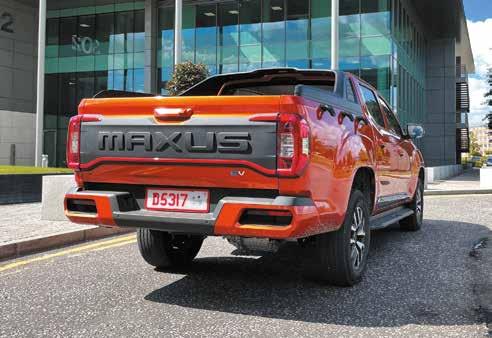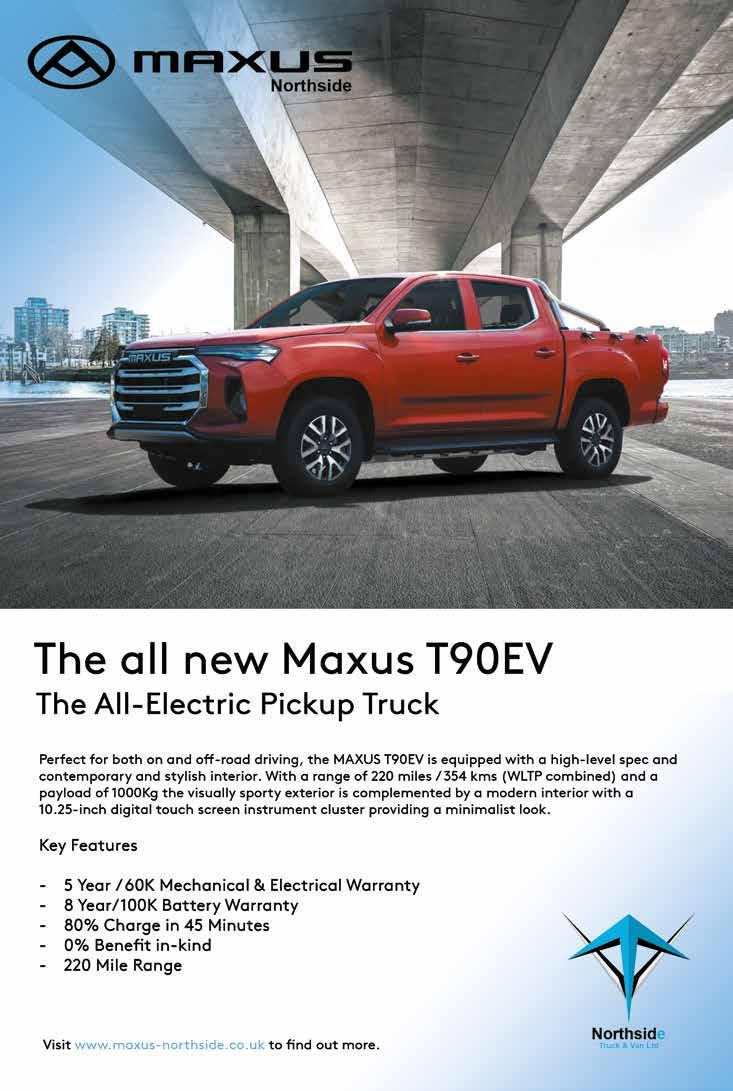




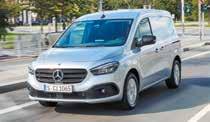

This year we will be running a regular feature on our Company Car & Van of the Year Award winners. First-up is Isuzu, whose D-Max retained our Pick-Up award. We review the V-Cross model and there are features on several Isuzu dealerships as well.
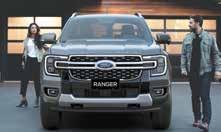

As more electric and plug-in vehicles arrive and fleets ponder how quickly they can switch to an EV fleet, our April print and digital issue takes a special look at electric motoring. We have an introduction from the BVRLA and other features spotlight EV fleet management, EV charging solutions, EV rental and EV leasing, with contributions from Mobilize, Sevadis, Europcar, Northgate, Caparison and My Car Direct
Also in this issue, we were fortunate enough to spend a week in the Range Rover Sport P400e, which comes with a classleading electric range of 70 miles and a BIK of just 5%. Our favourite BMW, the i4, is now cheaper, with an entry-level eDrive35 announced, while Lexus has another plug-in to shout about in the form of the new RX 450h +. And for those not yet ready to give up petrol, we also drive the Volkswagen Taigo small crossover.

On the commercial front, we visited the Toyota UK manufacturing plant at Burnaston recently to sample the greatly improved hybrid Corolla Commecial and have a look round the factory. Elsewhere, Ford’s all-new Ranger is in the spotlight, as are Mercedes-Benz’s new Citan and the Nissan Townstar panel van. We round off the commercial vehicle news with a review of the Maxus T90 electric pick-up, which we drove in Ireland recently.
Finally, we have a Q & A with Renault UK Fleet Manager Peter Horton, news from Marshall Toyota and Lexus Guildford introduces us to its Local Business Development Manager, Steph Dyson.

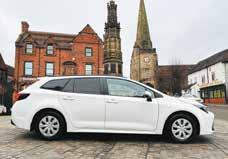 Andrew Walker, Editor and Publisher
Andrew Walker, Editor and Publisher
Although every efort is made to ensure the accuracy of material contained within this magazine, the publisher can accept no responsibility for omissions or inaccuracies in its editorial or advertising content. The views expressed in this publication are not necessarily those of the publisher. The carriage of adverts in this publication should not necessarily be viewed as an endorsement of the products or
advertised. All articles within this publication are copyright of Walker Advertising & Marketing Ltd. Editorial consent must be obtained before any are reproduced, either in printed form or


drive a V-Cross from the Adventure range, the model which is leading the way for the brand in pick-up sales.
Every version has a payload rating of at least 1,070kg, which is important for commercial vehicle tax purpose.There’s also a 3.5 tonnes towing capacity.
Isuzu’s new D-Max landed in the UK two years ago, at exactly the right time for the Japanese brand. Established players were exiting the sector and others were waiting for new models to arrive, leaving Isuzu in a great position to increase its foothold in the burgeoning UK pick-up sector.
The previous D-Max range-topper, the Blade, had a reputation for toughness, reliability and durability. What was slightly lacking, however, was the more car-like interiors, on-trend tech and safety features that you’d find on some of the competition.
The good news is, those former hallmarks are still there – this is a pick-up that will go almost anywhere – but it’s now much improved inside and now features the best safety in the sector, which is why it’s been the Company Car and Van Pick-Up of the Year for the past two years.
There are three D-Max versaions to choose from: Business, All-Purpose and Adventure. In addition these come in four trim levels: Utility, DL20, DL40 and V-Cross. To this list you can add the steroid-injected Arctic Trucks AT35. Company Car & Van had the opportunity to
The 1.9-litre 162bhp engine has been carried over from the previous model. Its ladder frame chassis, while similar to before, now comes with larger rails, additional bracing plus newer steels, all of which contribute to make it stronger. There’s a longer wheelbase, re-designed rear suspension, a shorter body, with increased load space both inside and out and a newly designed front and rear end.
For a start, there’s electric power-assisted steering, which makes a big difference to the truck both on and off road. The seats have also been redesigned and are now more comfortable, plus the dashboard is more upmarket with a new touchscreen infotainment system. All models now come with a height and reachable adjustable steering wheel, steering wheel mounted audio and cruise controls, DAB radio, Bluetooth, a front USB port and a 4.2” multi-information display.
The D-Max load bed is 30mm deeper than it used to be, so Isuzu has put a step into the rear bumper to make reaching in easier. Every Double Cab model now gets a tailgate damper. And, to make sure it complies with the Euro 6D emissions standard, the All-D-Max is fitted with a Selective Catalytic Reduction (SCR) system to reduce harmful nitrogen dioxide levels, so it has finally succumbed to AdBlue.
Another interesting point is that every variant of the D-Max weighs under 2,040kg, which means the Extended and Double Cabs are subject to normal passenger car speed limits. Many double cab pick-up trucks – Ford’s Ranger and the Toyota Hilux included – exceed this weight limit so must comply with goods vehicle speed limits, which are 10mph lower on single and dual carriageways.
That’s something many pick-up customers are still unaware of.
... or a muddy building site? Simple answer, yes. The latest D-Max is still perfect for anyone who needs to use their truck off-road. The selectable shift-on-the-fly 4WD drive engages faster, rear axle articulation has increased and all models bar the entry-level Utilitys come with a mechanical rear diff lock in addition to electronic aids that now include hill descent control and hill start assist.
It also has a wading depth of 800mm. We drove the latest D-Max through a flooded quarry on an Isuzu test day and up and down some serious sand and gravel inclines, finally racing it around a ready-made short course to prove its straight line and off-road handling ability.
It’s safe to say it passed everything we could throw at it with flying colours, and we’re sure it will for you, too.
The latest D-Max has picked up some airs and graces to go along with its existing ‘go-anywhere, carry anything. attitude, Andrew Walker reports
All double-cabs gain a radar system, with Isuzu choosing to use stereo-imaging via a pair of cameras at the top of the windscreen enabling the AEB, lane keeping, traffic sign recognition and intelligent speed limiter to work more accurately than offered elsewhere.
The new system also enables cross traffic alert, blindspot monitoring and emergency lane keeping, all new to the pick-up sector. And if that’s not enough, double cabs get eight airbags, while single and extended cabs have seven.
We utilised the Adaptive Cruise Control and autonomous Driving on the motorway and it works brilliantly.
Pick-up emissions and fuel economy are not a selling point – but then again, they rarely are on a pick-up. V-Cross manual offers 33.6 mpg/
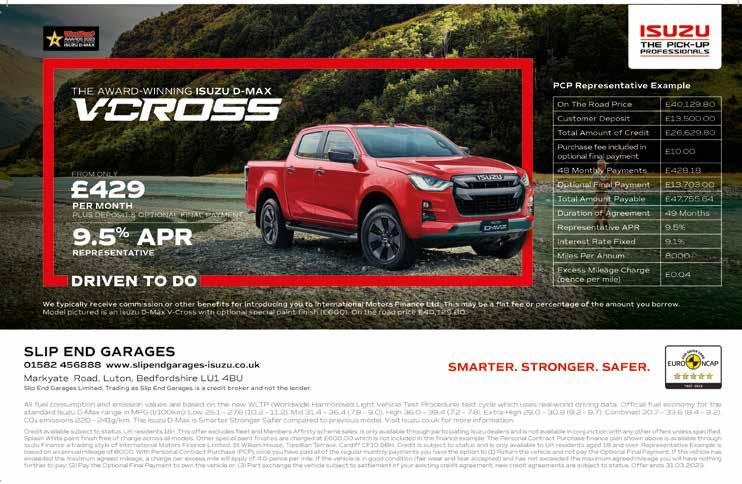
auto 30.7 mpg with emissions of 220g/km and 241g/km respectively.
V-Cross certainly looks the part and features distinguishing ‘Gun Metal’ exterior styling on the radiator grille, side steps, door mirrors, door handles and 18” alloy wheels. It’s also very well equipped with heated front seats, rear parking sensors, a reversing camera, Bi-LED headlights, LED front fog and an eight-way electrically adjustable driver’s seat. The 9” multi-function colour touchscreen is compatible with Apple CarPlay and Android Auto and comes with eight speakers, plus front and rear USB ports.
There’s also a dual-zone climate control system, an auto-dimming rear-view mirror and automatic headlight levelling. This is a pick-up tailored to the lifestyle sector.
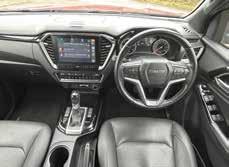
Overall, the quality of dashboard fixtures and
fittings is excellent, with just a few cheaper plastics used lower down. The seat finish has been designed to be practical as well as hard wearing. More good news is the short cut switches and standalone climate controls underneath the screen, which means there’s no fiddling with complicated on-screen menus while on the move.
The new infotainment system works wirelessly with Apple CarPlay and we were able to connect our iPhone to the V-Cross in about 30 seconds, enabling us to utilise Google Maps and Waze. We also made and received several hands-free phone calls via Apple CarPlay, listened to our favourite podcasts and kept abreast of goings on through What’s App.
As far as the touchscreen itself, the graphics are clear and response time is decent too. It all works seamlessly. If you drove the previous model D-Max, the new cabin is light years ahead.
The V-Cross is so much better to drive than the old D-Max models; indeed, you’d say that it handles the road more like a large SUV than it ever did before. Thanks to the electronic steering it’s easier to manoeuvre, and the bigger brakes means it stops faster. The seats are much more comfortable and coupled with the improved body structure, there’s far less body-roll.
Continued on page 6
Overall, the dashboard, fixture and fittings quality is excellent ... if you drove the previous model D-Max, the new cabin is light years ahead
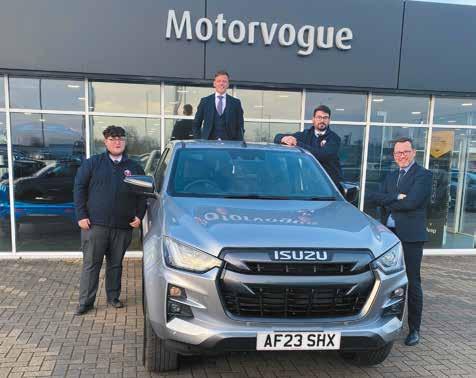
Motorvogue and Isuzu UK are pleased to announce the opening of Isuzu Kings Lynn, the latest dealership to join the franchise and the first in 2023.
Motorvogue Kings Lynn already represents Fiat, Abarth, Alfa Romeo, Jeep, Renault and Dacia from its showroom on Scania Way and is excited to add to its current offering with the new range of award-winning pick-ups.
The third-generation Isuzu D-Max pick-up –the latest in Isuzu UK’s line of highly prized commercial vehicles – is already attracting substantial interest from Motorvogue’s core customer base in Norfolk’s agricultural landscape, as well as from existing commercial customers from the Renault and Fiat Professional brands who are looking to expand their fleets with a multi-functional pick-up.
Motorvogue is one of the fastest growing independent motor groups in the UK, now offering new and used cars and commercial vehicles from 14 manufacturers across five locations; Northampton, Bedford, Kings Lynn, Norwich and most recently Bury St Edmunds.
Jon Pochin, Motorvogue’s Managing Director, said “We are thrilled to add Isuzu to our extensive portfolio. The multi-award-winning D-Max is certainly attractive to our customers from the trade, construction and farming industries and had not been available locally for several years following the closure of the previous dealership.
“With a dedicated Fleet Manager already positioned in the Group, we are able to offer appointments at places of work so customers interested in exploring the D-Max and test driving can do so with less disruption to their day. With our continued investment in people and facilities, we were well-positioned to accept the proposal made by Isuzu to represent them in West Norfolk and it is the perfect addition to our product range.”
The technological prowess and class-leading
safety systems of the Isuzu D-Max have received praise from renowned specialists, and it currently holds four prestigious awards for the best Pick-up of 2023 from What Van?, Business Vans, 4x4 Magazine and Company Car & Van.
The Isuzu D-Max range is available in single, extended or double cab body styles and offers class-leading safety along with proven off-road ability, SUV-like specification, a 1-tonne payload and a 3.5-tonne towing capacity.
It comes equipped with a punchy turbo diesel engine delivering 164PS and 360Nm of torque.
Each new model comes with a 125,000 mile / 5 Year Warranty and five years UK and European roadside assistance.
For those looking for a diverse range of fleet
Continued from page 6
Rear passengers get more leg room and there’s an improved ride, particularly on the motorway, where the V-Cross will cruise along happily. In town it is surprisingly agile and having just come out of a Range Rover, it’s really not that big on the road either. From start-up there is a diesel growl and this continues until you hit the magic 25mph, at which point it all becomes much quieter.
Pros
There is an excellent model choice of single, extended and double cabs, as well as good conversion options. Isuzu also has an extensive dealer network of pick-up experts to help you buy and service your D-Max.
The upgrades in safety, infotainment and quality have moved the V-Cross upmarket.
Cons
The 1.9 engine works fine in almost every situation, but it’s lack of out-and-out pull could be an issue for some, and competitors offer more oomph. In common with all pick-ups, there’s still some cheap plastics on the lower part of the dashboard, even on the V-Cross. And, if the load bed is empty, even with the new ride improvements, rear seat passengers should expect the occasional bumpy ride.
Conclusion
While other pick-up manufacturers have shied away from the sector, Isuzu is to be
vehicles including cars and vans from the vast selection available at Motorvogue, the Business Fleet Specialist can discuss all options with you to find the perfect vehicle solutions.
With Isuzu-trained technicians, parts supply and the latest diagnostic equipment, existing Isuzu owners are welcome to visit Motorvogue for all of their servicing and maintenance requirements at Scania Way, Kings Lynn PE30 4LP. Demonstrator vehicles are also available for those looking at the possibilities for their business and personal use.
Contact the Sales Team on 01553 772644, or visit Motorvogue.co.uk/commercials/isuzu to arrange your appointment and discover the latest offers available on the D-Max range.
congratulated for making its most popular truck, much, much better than before. Furthermore, the D-Max not only looks and drives better than before, it now features class-leading safety, on-trend tech, a far better passenger experience and does most of what a pick-up is supposed to do.
Definitely, a job well done.
Does everything you need a pick-up to do but with more than a nod to lifestyle owners. Test one and you’ll see why it’s been our award-winner two years on the run
CC&V
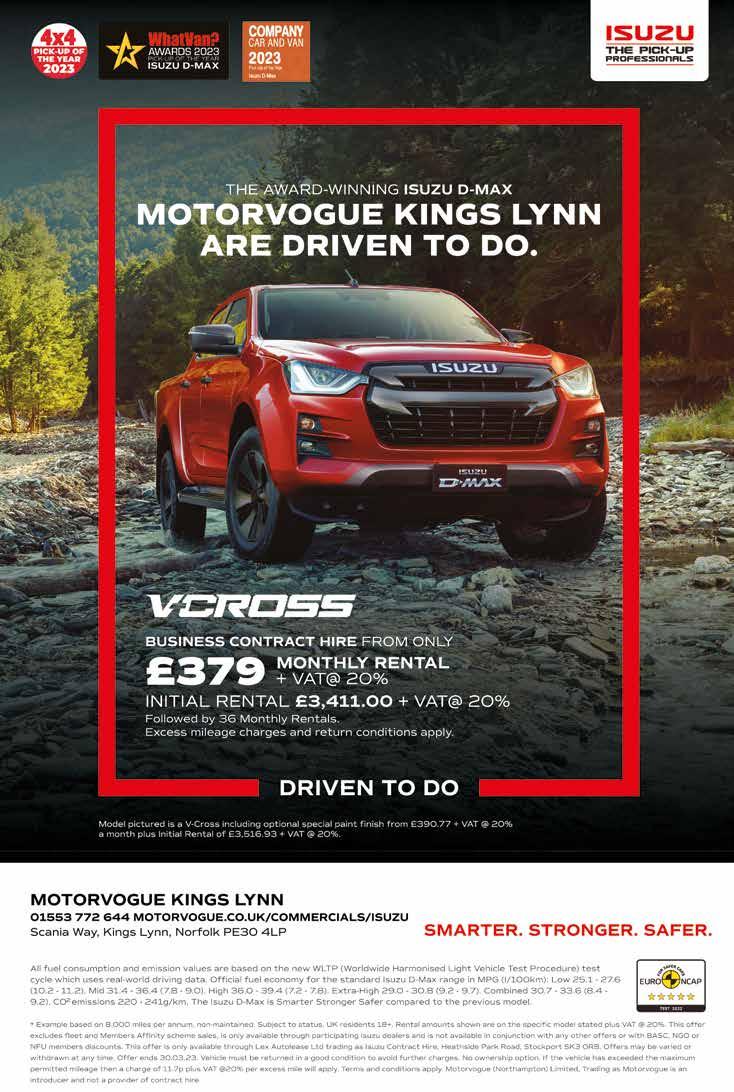

Livingstone Motor Group is now the only Isuzu stockist in Hull – with a wide range of Isuzu vehicles in stock at the dealership on Livingstone Road, Hessle, HU13 0EG.
And with the huge success of Isuzu the dealer has expanded to incorporate a dedicated commercial department.
As a leading provider of high-quality commercial vehicles, Livingstone Motor Group is committed to meeting the diverse needs of its customers. Isuzu vehicles are known for their durability, reliability, and fuel efficiency, making them the perfect choice for businesses of all sizes. Whether it’s one or a fleet of pick-ups you need, get in touch and the team will be sure to deliver on the promise to care, listen and deliver to every customer! With specialised business discounts including BASC and NFU members, with their 30 years pick-up experience there is only one placed to go.
From a single cab working vehicle to the popular V-Cross, the Isuzu D-max is a perfect vehicle for businesses in a range of industries, including construction, transportation, and
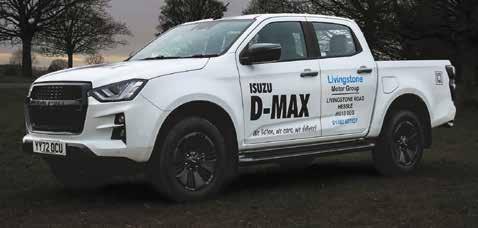
logistics. In addition to offering a wide range of vehicles, Livingstone Motor Group is committed to providing its customers with exceptional service.
The team of experienced technicians is on hand to provide maintenance and repair services, keeping your Isuzu vehicle running smoothly for years to come.
They also offer a range of aftersales services such as extended warranties, servicing and MOTs, and are also equipped with an approved bodyshop for any accident repairs.
Great selection
Contact Clive Thompson, Livingstone Motor Group’s Commercial and corporate executive, at Livingstone Road, Hessle, on 01482 627527 or via clive@livingstonemotorgroup.co.uk. Alternatively, view a great selection of Isuzu vehicles at www.livingstonemotorgroup.co.uk. The team is ready to make buying your next pick-up easy, cost effective and hassle free. Don’t miss out on this opportunity to experience the performance and durability of Isuzu vehicles.
‘We listen, we care, we deliver’
RVT Commercial Vehicles was delighted to be named Isuzu’s Central Region Dealer of the Year Award at Isuzu UK’s annual Dealer Conference for 2022. It was also runner-up in the Contract Hire Dealer of the Year award
Taking place in Manchester earlier this year, the conference and awards event brought together Isuzu dealer partners from across the UK and was hosted by TV personality and entertainer Sean Williamson.

This is the second consecutive year RVT have won Dealer of the Year for their region, and Group Managing Director Steve Petford was delighted with the accolade. “This is a fantastic achievement for the RVT Commercial Vehicles team, recognising the high standards of customer service they offer and a great start to and exciting year ahead. Many congratulations to Scott, Philip and the rest of the Isuzu team on their huge success.”
RVT Commercial Vehicles has been part of the Isuzu network for six years, having founded the dealership at its existing Shrewsbury depot in 2017, from where Rea Valley Tractors was known for service and support to the agriculture
sector in Shropshire and the surrounding areas. When it branched out into the automotive industry, RVT Commercial Vehicles wanted to bring the same core values, dedication to service and support for its loyal customer base.
The team is headed up by Scott Thomas, and supported in sales by Philip Joseph; both have extensive experience in the automotive industry.
2023 will see the start of building developments as a new showroom, workshop and aftersales department at the Shrewsbury site gets underway. The dealership sells over a 100 trucks a year, with a aftersales back up support of fully trained brand specialist technicians.
General Manager Scott Thomas says the
dealership has faced some serious challenges since he joined five years ago, “with a global pandemic just as we were finding our feet in the Pick-Up market. Vehicle production came to a halt, but our team pushed on and adapted to a new way of doing business, managing to maintain the service levels that our customers had become accustomed to.”
He added: “There’s light now at the end of the tunnel. RVT Commercial Vehicles has come out of the pandemic stronger ‘firing on all 4’ and continuing to push the Isuzu brand within our area”.
• For more details please visit RVT’s website rvtisuzu.com or call 01743 289200

Independent vehicle supply specialist Vanaways has fired the starting pistol on a race towards significant expansion in 2023, by moving its staff to a stunning new office complex.
The building represents a massive upgrade over its previous headquarters and is designed to give the ambitious company space to grow.
The site at Eden Office Park, Ham Green, Bristol is just five minutes from Vanaways’ previous home but a world away in terms of space and quality of both office accommodation and parking facilities.
“We’d already outgrown the old office and the fact that we have big plans for the coming year meant a move to a much more spacious and better-equipped base was a pressing need,” said Director Adam Carter.
“The new site is a great improvement. It allows us to have dedicated areas for our various teams as well as break-out spaces and rooms for client meetings and conferences. There’s lots more parking available too, for both staff and visitors, and the building presents a smart, professional face which reflects our approach to finding the best vehicles at the most competitive prices for our customers.”
Vanaways’ sales force is split into three sections. The successful retail team, which trades under the name Van Sales UK, has been the core of the business since its inception in


2017 and is focused on dealing with incoming inquiries.
New in 2022, though, was the addition of a Business Development Team, with a brief to target more prospective customers.
Last year also saw the establishment of a ground-breaking partnership with leading trade and DIY retailer Toolstation, under which vans are marketed through its network of more than 550 stores nationwide as well as online. A dedicated unit has been set up to deal with this business.
The expanded accommodation has also allowed marketing, accounts, procurement, customer service and administration colleagues space to create their own workspace areas.
“In total we now have 45 people working here but we’re actively recruiting so that’s growing all the time,” continued Adam. “The opening of this new office is the final piece of the jigsaw that we
spent much of last year assembling – along with the Toolstation partnership, a series of key senior appointments and a drive to attract new customers to our brand.
“We confidently expect these developments will help us to hit our initial target of 10,000 vehicle sales per year very soon – and then to use that as a springboard for even greater expansion.”
Vanaways is an internet-based business. Its sales experts work over phone and email networks to quickly match customers up with their perfect vehicle selections, with an emphasis on making the process as simple, quick and efficient as possible.
Vehicles are typically ordered and supplied, to tight timeframes, without the customer ever having to leave their place of work. The absence of an expensive showroom or large standing stock also keeps overheads to a minimum, so pricing is highly competitive.
Adam continued: “We’re not tied to any manufacturer so can source whatever vehicle a customer wants. But for many people these days, the badge on the front of their van is less important than a hassle-free acquisition process. That’s where we score; by speeding up the journey from production line to the customer’s premises, and by providing the best value for money with minimal paperwork.”
Thanks to the BIK benefits, the fleet sector has adopted EV/PHEV much faster than retail and will continue to do so if the government continues to incentivise these vehicles and charging infrastructure keeps pace, writes Company Car & Van In this section we ask a number of EV industry experts to share their expertise on everything from charger supply to EV rental and leasing.
To open up, Catherine Bowen, senior policy advisor at the BVRLA, has looked at the issue of ‘charge anxiety’ and asked if the UK’s current charging network is fit for purpose – and the steps that must be taken to ensure it is ready to supply the power to the people, and make sure electric motoring works for everyone.
Catherine Bowen, senior policy advisor, BVRLA
Electric vehicles are getting better and better. New launches bring more choice every week. Greater variety is meeting more needs than ever. This acceleration of performance and vehicle diversity means that fewer and fewer use cases have a genuine reason not to go electric. The spectre of range anxiety is diminishing every day...
But are we entering a new era of charge anxiety? There are certainly signs that the UK’s charging infrastructure is causing increasing concern.
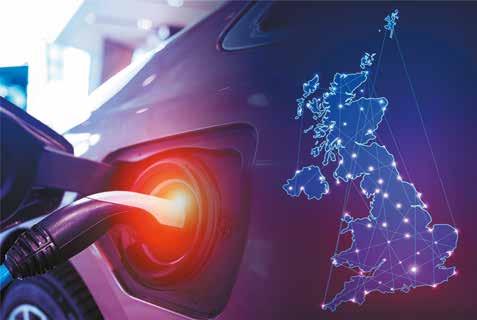
Can drivers rely on easy access to infrastructure when they most need it – at busy periods around the key motorway networks, for example. We are seeing too many reports of charge points being inoperable, inaccessible, or inundated. These concerns multiply when considering vans.
This will change. It has to. Charging infrastructure is one of the Government’s top priorities and we have been telling officials where and how support is needed. They have responded with confirmation of additional funding, plus real-world trials through the Local Electric Vehicle Infrastructure (LEVI) programme.
This year we will also see a step change in how local schemes are rolled out. More powers are being given to local authorities, handing them the responsibility to develop and deliver plans that create a local charging infrastructure fit for their region’s needs.
While this supports local solutions for local challenges, it will only be successful if the right information reaches the right teams. Collaboration is critical. As a fleet sector, we need to share our insights, knowledge and solutions so local authorities can make informed, fleet-friendly decisions.
Recent research by the BVRLA shows that
barely a third of local authorities already have an EV strategy in place. More worrying is the news that only 3% of authorities nationwide have actively engaged with the fleet sector. This must change.
Local authorities and MPs are calling out for support. The BVRLA’s Parliamentary Reception in March was evidence of that. Politicians and decision-makers want to know how to best meet the needs of the drivers and businesses in their constituency. As part of the event, they actively pledged to support “the rollout of a fleet friendly EV infrastructure”.
When compelling, data-led cases can be made to them, showing what charging infrastructure is required, they can put more targeted, effective plans in place.
It is up to us as the fleet sector to ensure we are part of the conversation and having our voices heard. The BVRLA is committed to shaping those conversations to represent fleet
needs as regularly as possible. Our updated Fleet Charging Guide contains 18 recommendations for LAs.
They span six distinct areas:
• matching types of provision to emerging gaps in infrastructure
• building trust
• ensuring consistent ease of access
• taking a holistic approach
• overcoming grid capacity challenges
• delivering appropriate infrastructure for rental operators at airports
The guide and its recommendations go hand in hand with our local authority research, from which we have created our Fleet Friendly Charging Index. This shows how different authorities compare to each other and how they are performing when it comes to meeting fleet charging needs.
Armed with the Guide and the Index, we are supercharging our engagement with local authorities. Both are readily accessible on the BVRLA website. We are urging all fleet professionals and business owners to explore the Index to see the situation in their region. Contact details are also provided to reach out tolocal authorities directly; the BVRLA’s policy team can assist you with
Only by collaborating closely with local authorities across the UK can we shape a nationwide EV infrastructure that works for everyone.
This year we will also see a step change in how local schemes are rolled out. More powers are being given to local authorities, handing them the responsibility to develop and deliver plans that create a local charging infrastructure fit for their region’s needs.
Catherine Bowen, BVRLA
Once an EV charging installation project is complete, businesses often think ‘that’s it now, we can recharge our vehicles.’ In essence this is correct, however, have you thought about the scalability of your EV charging infrastructure prior to implementing the EV charging plan of action?
While most SMEs are in a position to install two-five electric vehicle charging points in the immediate term, that figure has the potential to increase in the coming years as business decision makers transition to an all-electric fleet for business operations.
Scalability in this circumstance holds significant importance. While two-five EV charging points may provide the facilities to recharge the fleet you currently operate, when you introduce more EVs onto your fleet, the number of charging points needed will potentially increase. In order to ensure a scalable solution is deployed, together with your electrical installer and EV charging solutions provider, identifying the level of infrastructure your site can withstand is the first step. Are you able to install the number of EV charging points you require in the immediate term with your current supply, while also having the option to increase the number of EV charging points in the future? This is a key point to take into account, should your business operations transition to a fully-electric fleet.
One of the fundamental benefits of understanding your site’s capacity for immediate and future EV charging points is the ability to forecast the requirement, if any, of additional work to ensure your fleet’s requirements are met in the long-term. Should there be any hurdles, these can be addressed sooner during the first phase of installations, for example, installation of the additional infrastructure to accommodate the increasing demand further down the line. These considerations not only prepare your business for the coming years of electrification, they also provide a streamlined approach in which expectations of capacity and demand are managed, avoiding disruption to overall transport operations to the business.
Knowing exactly how many EV charging points your site can power is a critical piece of information, which in turn provides the starting point for a robust fleet electrification plan.

When the capacity for EV charging points at your premises is defined, choosing a reliable and scalable solution that meets the requirements for both short and long term plans is advised. This element in the decision making process also includes the consideration of an EV charging management system, again future-proofed and capable of remotely keeping your charging points up-to-date and operating under new and emerging changes.
For more on how Sevadis can support your fleet electrification plans, visit sevadis.com.
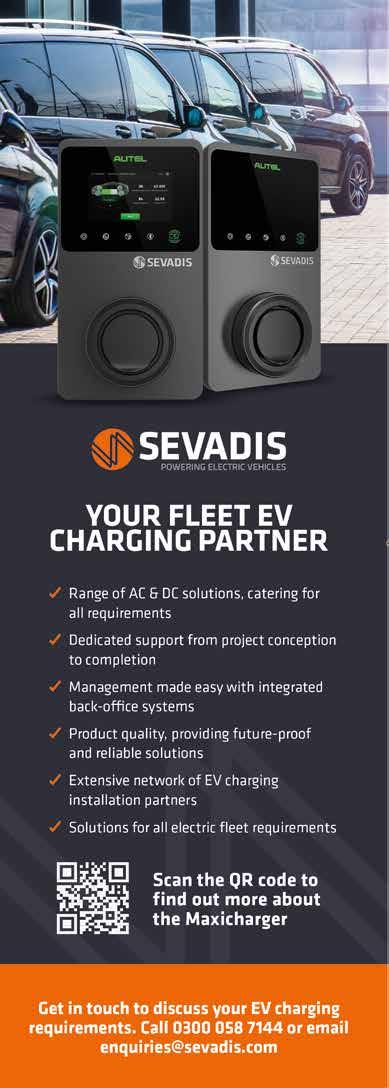
‘‘
In recent years, sustainability has become an increasingly common buzzword. But what does it mean for businesses, in real terms?
Business mobility can have a significant impact on budgets and carbon emissions. Cutting down on how often and how far employees are required to travel and changing their mode of transport can provide substantial savings on both fronts. Indeed, the increasingly popular hybrid working model is changing many aspects of business travel.
But people and goods still need to get from A to B and employers are looking to their fleet and business travel managers to think about how this can happen with sustainability as a core driver.

On
Recent Europcar research found that businesses are looking at several sustainability targets relating to mobility. The most common, a target for 29% of respondents, is to increase use of alternative mobility solutions such as cycling and walking. This was closely followed by increasing the number of electric vehicles on fleet and an overall reduction in business travel (see graph above).
Encouragingly, over half of respondents said they already have fully electric vehicles on their fleet; 54% also have hybrid vehicles. But the reality is that very few businesses are making a
wholesale switch to electric right now. Instead, a transitional strategy, reducing emissions alongside testing new powertrains, is being widely adopted. And this will become ever more important as the current vehicles on company fleets get older.
Employers also need to adapt their mobility choices to ensure the growing number of Clean Air Zones coming into force in cities across the UK this year doesn’t hit their bottom line. Being able to access compliant cars and vans as and when they’re needed makes a lot of sense.
When it comes to electric vehicles, over half of the businesses surveyed said they provide charging at company premises; over half also contribute to at-home charging costs. So, the
‘range-anxiety’ challenge is being addressed. However, other barriers do persist. Fleet supply is holding back 29%, while a similar percentage are hesitant due to lack of understanding around the cost of maintenance, repairs and charging.
Businesses and drivers need to understand what is right for them now and in the future, and a try-before-you-buy option will give the driver and the business a real-world picture of all areas of electric vehicle ownership. This will not only reassure businesses that the investment in a greener fleet will work with their business operations and bring business benefits. It will also help dispel any concerns drivers have regarding charging infrastructure and driving range.
Of course, another advantage of rental is that there’s no long-term commitment, unlike leasing or outright purchase. So the risk of switching to electric doesn’t have to come with a three-year fixed term.
To find out more about how Europcar can help your organisation’s decarbonisation journey visit www.europcar.co.uk/business/electric or call 0371 384 0140.

With nearly 60% of plug-in vehicle registered to businesses*, the company car market company is moving fast towards electric. However, all of these cars need charging and knowing the best and most efficient way to charge is key to getting the most out of your electric vehicle. Mark Dickens, managing director of Mobilize Power Solutions, a European leader in business and home charging solutions, helps you decide what is the best way to charge your vehicle.
Home charging remains the most convenient and cheapest way to charge your vehicle, with a full charge costing around £15**. Furthermore, if you are lucky to have an off-peak tariff it would cost you even less and you charge when the car is most likely to be unused – late at night. This way of charging makes electric vehicles much cheaper to run (a typical 1400cc petrol engine vehicle would cost around 22p*** per mile rather than around 10p per mile on electricity) and if you are travelling around 8,000 miles a year, this could potentially save you nearly a £1,000 in running costs.
However, make sure that the charger you install meets UK regulations to protect your domestic electrics and importantly, has smart charge capabilities, allowing you to schedule your charging to ensure your vehicle is ready and charged when you need it or when the cost of your electricity is at its lowest.
At Mobilize Power Solutions, we also believe that having an expert to advise you on where your charger should be positioned and checking if your home electrics are up to date will give you peace of mind – and that is why we also include a physical home survey in the price of our charger.
For businesses that run a fleet or who want to encourage their employees to drive electric, installing workplace charging helps manage the cost of running company vehicles. In addition, charging at work is seen by many companies as a staff incentive and can help the business achieve its sustainability goals. What’s more the Government’s Workplace Charging Scheme contributes up to £14,000 towards the upfront cost of the charge points and infrastructure, making this investment more affordable.
At Mobilize Power Solutions, our business charging solution also integrates Mobilize Manager, which provides real-time data from across the company’s charging network that not only ensures every charger is working properly but helps calculate costs and monitor driver’s charging behaviour.
Combined with Mobilize Business Pass, drivers can also be identified, given access to, or blocked from using the on-site chargers at certain times. The Mobilize Business Pass comes as an RFID card or as an app and is also accepted across a network of public charge points, so business drivers can charge on route.
In addition, it simplifies business ‘on the go’ charging costs as the company is charged back directly for the energy consumed.
Unfortunately, public charging facilities have been given a bad rap in the press – often because they don’t seem to work or because there are not enough points across the country to serve the growing number of electric drivers. However, talking to many of our electric vehicle driving customers, in reality most of the time these chargers are available and are only really used when necessary, as charging from home or work is less expensive and more convenient. This is not to say that this is a vital ingredient to the successful take up of electric vehicles and that there must be more investment across the national charging network. This is happening already and Zap Map reports that there has been 33% increase in the total number of public chargers since February 2022.
So, what are the real challenges to fleets and company car drivers transitioning to electric, now that most vehicles have sufficient range and the charging options are expanding and

My biggest piece of advice is – start the process now and plan for the future.
Businesses need to look at what their fleet needs now and what they need to support the businesses’ growth, as well as where the critical charging hubs will be – at home, at the office, the depot or on the road. Also, consider workplace charging infrastructure projects can take anything from 2 months to 18 months to complete (depending on the local energy supplier, planning requirements and lead times on hardware).
At Mobilize Power Solutions, we understand these problems and can manage the project from start to finish – helping the business to secure the Government Grant and even seek finance though Mobilize Financial Services, through to installing the most appropriate charge points and identifying significant charging hubs as well as tailoring your management software to your business operations.
So, what are you waiting for? Just press the go button and start your electric journey. For more information about electric vehicle charging go to: www.mobilize-power-solutions.uk
As the UK Government strives towards electrification, salary sacrifice schemes have a crucial role in supercharging the widespread adoption of electric vehicles among the population.
Salary sacrifice schemes are becoming increasingly popular as a result of the considerable staff and employer benefits on offer. However, the most important benefit for our economy could prove to be their ability to make EVs affordable and attainable.
In the current market, electric cars are often priced at a premium when compared to their nearest combustion engine alternatives. Unpredictable production and battery costs in the current climate could mean the consumer might still be some way off financial parity between the two.
However, by signing up to a workplace salary sacrifice scheme, employees can make substantial monthly savings on the latest electric car lease deals.
They will be the main beneficiaries of the 2% Benefit in Kind tax rates, which have been fixed until April 2025. It’s the favourable BiK tax rates placed upon EVs that allow for such sizeable monthly savings, while negating some of the fears that can surface, like large upfront fees or excessive monthly payments.
Considerable savings are also there to be
made on National Insurance and Income Tax. With the ability to save hundreds each month when compared against a Personal Contract Hire lease, salary sacrifice schemes make the prospect of an electric car increasingly more cost-effective and efficient to lease for the masses.
Of course, employees are not the only party making savings. When an employee exchanges a portion of their salary, businesses also make sizeable savings on National Insurance and pension contributions.
As businesses become more eco-conscious, carbon neutrality becomes a more poignant target for SMEs and corporate institutions. A thriving salary sacrifice scheme will reduce your companies’ carbon footprint and make a valuable contribution towards any corporate social responsibility targets.
Paula Mace, Head of Corporate Mobility at Corparison, says: “Businesses now have to work harder than ever to attract new staff and retain their current workforce in this current climate. A salary sacrifice scheme is a fantastic incentive that supports both.
“It creates significant cost-saving opportunities for the employers, but it’s also hugely valued by employees when we’re all
trying to make our money work harder.
“Historically, salary sacrifice schemes have been self-serving and offered with very little support. We do things differently. Corparison’s consultative approach allows us to help businesses and employees find the right vehicle for their lifestyles. There’s also early termination insurance and contingency plans to protect the employer.”
Experts in fleet management and supporting businesses in their transition to electric, the Corparison team are on hand to help your company roll out a successful and cost-effective salary sacrifice scheme.
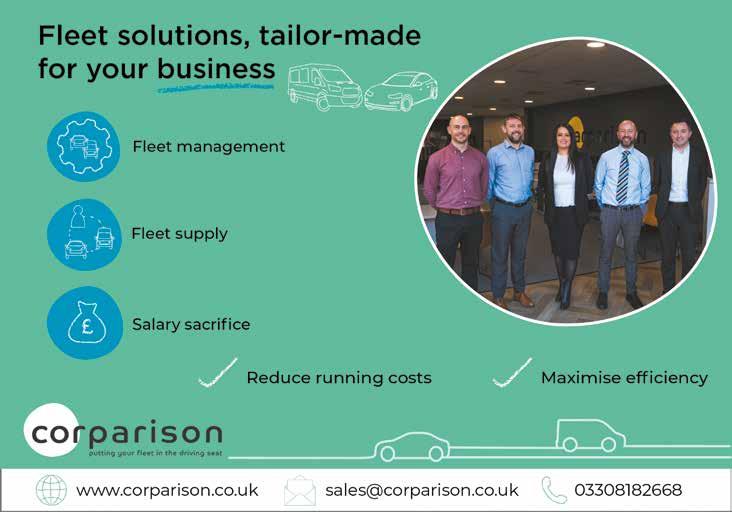
Trusted by a leading panel of funders, Corparison can access every make and model of car at the most cost-effective price for your employees. By utilising their industry-leading salary sacrifice calculator, employers and employees are able to see accurate and up-to-date figures to forecast the savings available.
Want to know more?
For more information on how Corparison can help your business, contact Paula Mace on paula.mace@corparison.co.uk, call 03308182668 or visit www.corparison.co.uk
Northgate’s innovative fleet electrification programme, Drive to Zero, provides customers with a full suite of solutions designed to aid fleets’ transition to electric LCVs.
For over two years, Northgate has continued its transformation into a LCV fleet solutions provider and has been building the foundations for its own electrification journey, alongside those of its customers.
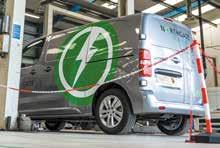
Neil McCrossan, Northgate Vehicle Hire’s sales and marketing director, said: “In line with the Government’s deadline for internal combustion vehicle sales ending in 2030, Northgate has been committed to ensuring that our customers are fully supported by us in advance of this.

“We understand that for businesses, a lack of interruption is key while undergoing any fleet transition, and electrification is no different. We have launched Drive to Zero in order to make this transition as seamless and efficient as possible.”
Drive to Zero comprises five key elements, which together make up the electrification programme designed to ensure a seamless transition of all businesses.
A thorough fleet analysis is the first step in any transition, assessing EV suitability for transition. Through the interrogation of telematics data, Northgate builds a complete understanding of vehicles, their movements, distances travelled and journey times, which gives an understanding of which vehicles can be immediately switched to electric power without issue and which ones will come on-stream as higher range electric LCVs are launched over the coming years by OEMs.
They can then offer vehicles on trial to fleets prior to a longer term commitment.
Vehicle choice is key for successful fleet management, and Northgate works closely with OEMs to continually add to an industry-leading range of electric LCVs. From final mile solutions such as the Renault Zoe commercial hatchback, through to mid-sized panel vans such as the latest Peugeot e-Expert, Mercedes Benz e-Vito or even the larger Mercedes Benz e-Sprinter, Northgate offers a leading proposition within its 12 months+ rental option.
As EVs are in high demand, and with delays in new vehicle lead times, Northgate pre-orders EV stock, ensuring whenever a customer is ready to electrify, there is always a suitable vehicle ready for use.
As servicing and maintenance remain a key consideration for EVs, Northgate has invested heavily in its workshops and 67-strong branch network, ensuring that trained EV technicians are employed at each branch across the country.
In order to aid driver training around best practice for EVs, Northgate has a full suite of EV training modules available to help address challenges and help drivers adopt new driving techniques to optimise EV range. Free to all its EV customers, the broad suite of learning modules help drivers up-skill with ease on all manner of subjects, from EV driving best practice, to charging, and a host of other ‘how to’ topics in between.
Since the provision of suitable charging infrastructure is a crucial step to ensuring a smooth transition for any business, Northgate works with leading EV charging installation experts ChargedEV, part of the same Redde Northgate group, to ensure that whether a customer needs to consider workplace charging, home charging or even public charging facilities, the best possible solution can be found. It can also
help and support with major infrastructure planning which involves working with local energy suppliers to install and futureproof a company’s charging needs.
Better still, Northgate is the only rental provider which combines van rental and charger provision as a single bundle, offering EV hire, and home charger installation and rental in a single monthly fee.
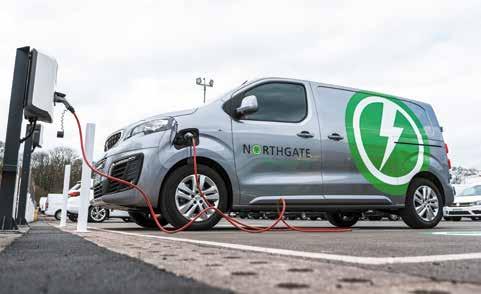
Finally, Northgate’s team of EV fleet specialists are available to help fleets develop and implement robust transition plans, bespoke for each customer.
The proposition is designed to let fleets focus on their core business, while Northgate focuses on running their vehicles. With rental services and a flexible approach not found with more traditional fleet funding methods, with Northgate, the Drive to Zero is assured to be smooth.
“We understand that for businesses, a lack of interruption is key while undergoing any fleet transition, and electrification is no different. We have launched Drive to Zero in order to make this transition as seamless and efficient as possible.”
Neil McCrossan

Three years on from the first lockdown, the misery of the pandemic is mercifully in the rear-view mirror, but it’s effects on modern working practices remain with us.
Hybrid working, digital nomading and the increased primacy of e-commerce are here to stay. Fortunately, the fleet industry is moving with the times.
Car subscription has been designed from the ground up to offer a fleet solution for businesses operating in the increasingly flexible and automated post-Covid world. With the option to cancel, extend or swap into a different vehicle at any point during the contract, car subscription allows your fleet to be as agile as your business, while the all-inclusive nature of the subscription eliminates tedious procedures and unexpected running costs.
Subscriptions can run from anywhere between 1 and 48 months, which positions them as not just a long-term solution, but also the perfect answer to fleet shortfall. An unfortunate enduring symptom of Covid-19 has been the disruption to global supply chains, particularly cars. Six or even nine-month waiting times for popular makes and models are not uncommon, with just getting your hands on a
car posing a challenge. Car subscription offers a solution; if one of your employees is faced with a long wait for the company car of their dreams, you can subscribe to an equitable vehicle on a flexible short-term contract while you await delivery.
The beauty of subscription lies in its flexibility. Traditionally, acquiring a new company car means either buying a new car outright, or leasing it on a long-term contract.
Buying a new car incurs a large upfront cost, and labours your business with an expensive, rapidly depreciating asset.
Leasing a vehicle avoids the upfront cost, but leaves you locked into a contract for years at a time.
Subscription, by contrast, alleviates both the burden of a large upfront payment and the risk of a long-term contract which cannot adapt to your business needs. So if your business is disrupted by external forces, you aren’t stuck with a fleet of company cars gathering dust, unwanted, unused and costing you money.
This flexibility can also add value to your business. If you need short-term contractors or specialists to complete a project, or you’re bringing in new hires on probation, subscription
is the perfect way to provide them with a company car. With subscription cars on fleet, you won’t be caught out if a new hire doesn’t work out, and can offer a company car to contractors, adding value to your contract offers, so you can bring onboard the best people.
Subscription can also ease the transition from internal combustion to electric. Contrast Europe’s best-selling EV in 2018, the Nissan Leaf, to the Tesla Model 3 in 2022, and over the lifetime of a four-year lease the EV market has undergone a paradigm shift. The rate of technological development is so great that it no longer makes sense to lock yourself into a long-term commitment to an electric vehicle, as its battery degrades, and the vehicle is rapidly superseded by the latest models.
If you think car subscription could be right for your business, then look no further than mycardirect. Our flexible subscription service can provide the company cars you need in the short term, and benefit your business in the long term. Visit www.mycardirect.com or call 0333 0155 055

CC&V: We’ve just driven the Megane E-Tech electric and came away really impressed.Is Renault looking to target SME fleet sales with this model, or are you holding it back for retail customers?
Peter Horton, Head of Fleet, Renault UK: Yes, we are seeing demand in fleet channels for the All New Renault Megane E-Tech 100% electric. We want to adopt a balanced channel approach and for all future models our primary focus will be on longer cycle channels where there is a draw for the vehicle, such as a salary sacrifice schemes and user-chooser fleets. This is also consistent with our focus on protecting residual values.

CC&V: For many SMEs, plug-in hybrid is a more attractive way to achieve a greener fleet and lower BIK than full-electric. You have a PHEV Captur on your range. How have these been received by SME fleets and have you seen success in the form of sales in our sector?
PH: PHEVs are a great alternative for those drivers who are not yet able to make the switch to a fully electric vehicle. We are seeing that drivers of smaller B-Segment cars are already making the switch to BEVs, with 20 times the volume of small BEVs registered last year, compared to small PHEVs.
In the medium and larger car segment fleet markets, the demand for PHEVs remains more prevalent. If for any reason a BEV does not work for a driver then the Renault Captur PHEV offers great versatility and practicality with the benefit in kind savings associated with the powertrain.
CC&V: We were lucky enough to spend some time with Renault in France last Summer where we were introduced to Mobilize Power Solutions, which is part of the Renault family. How is Renault Fleet utilising Mobilize’s expertise and have you seen progress in offering a full electric solution to your fleet
PH: We already know that many of our fleet customers want to make the transition to low and zero carbon emissions mobility, however, as is quite often the case, customers simply do not know where to start. However, together with Mobilize Power Solutions and Mobilize Financial Services we can provide a simple turnkey solution for fleets and their drivers to help them optimise and manage their electric vehicles.
Mobilize Power Solutions’ expertise enables us to combine electric and plug in hybrid vehicles with appropriate compatible charging solutions that are suitable for the workplace and the home – as well as a roaming application that allows drivers to charge on the go, at over 4,000 public charging facilities across the UK.
In addition, its back office management software helps fleets monitor energy consumption and costs, as well as review and control driver charging behaviour – ensuring that the fleet management enhanced.
What’s more the Mobilize umbrella also covers financial services, which helps make electric charging infrastructure investment more affordable. All of this together, means that we can provide fleets with a comprehensive, value for money electric fleet proposition.
CC&V: As more electric cars enter the market place, why should customers consider a Renault EV or Plug-In as their next company car?

PH: Renault is a pioneer of electric vehicles having been in the BEV market for a decade since the launch of the Renault Zoe. With our ‘Renaulution’ strategic plan, Renault has embarked on an ambitious, value-generating transformation moving towards a more competitive, balanced and electrified range. Having been one of the first to operate in this market we have been able to use our
the latest generation of electric vehicles, such as the All New Renault Megane E-Tech 100% electric, but also in our aftersales network.
CC&V: Does Renault still have a corporate dealer network, and what help can customers expect from these dealerships, if they choose a Renault vehicle?
PH: Renault does have a dedicated network of fleet specialist dealers under our Pro+ banner. These fleet specialists not only offer additional sales support, including a fleet contact to support customer enquiries but also additional aftersales support that recognises the impact of downtime on business operations. This includes replacement vehicles, parts and labour warrantees and diagnosis prioritisation.
CC&V: When it comes to electric cars, SMEs are still suffering from range anxiety and access to charging points. While full-electric has to be the way forward, do your plug-inhybrid models have an important role to play in the transition to cleaner fleets?
PH: Last year over 100,000 more BEVs were registered in the core fleet than PHEVs. This highlights the fact that more fleet customers than ever are confident in making the transition to the newest generation of BEVs without the need to use PHEVs as a stepping stone to zero emissions.
PHEVs will still provide an import role in the transition to cleaner fleets, however, in many cases they are a compromise choice for those customers where BEVs are not currently an option due to operational reasons.
Crucial to removing the notion of PHEVs being a compromise and encouraging the uptake of BEVs is to address access to charging, which our PHEV customers have signalled to us in more important to them than
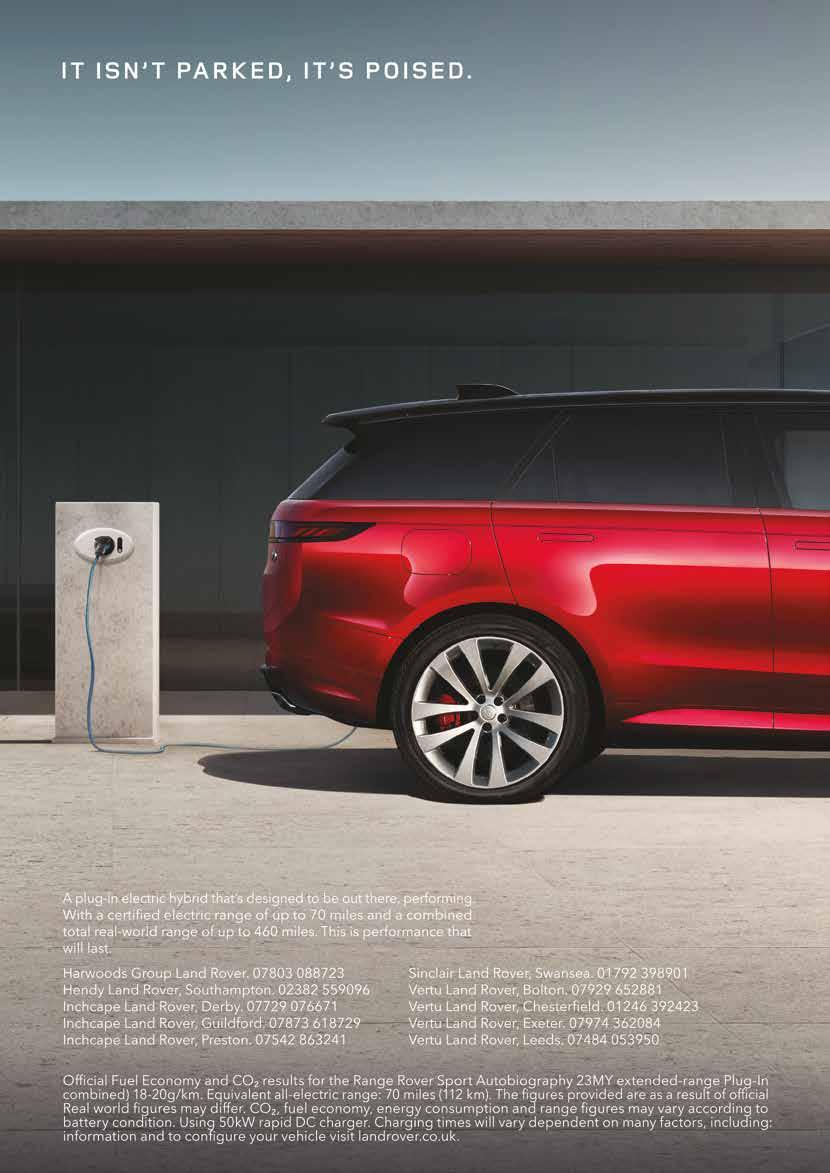

Andrew Walker writes... We motoring writers are spoilt: A different car or van to review every week. Tough life.
However, after 30 years in the game, even I have to agree that when the car in question is the all-new 2023 Range Rover Sport P400e, it’s really not tough at all.
Two plug-ins are offered: the sensible P400e and the more powerful P510e. Our test car costs an eye watering £87,475, but that’s not the point. The model’s low BIK of just 5% makes the P400e, in relative terms, a bit of a bargain.
Electric cars are coming to the Range Rover brand, with an all-electric model due this year. However, if you do drive longer distances several times a month, but can take advantage of shorter trips the rest of the time, what this plug-in offers is a brilliant compromise.
Underneath the floor plan sits a 38.2kWh battery that’s almost twice as large as anything the competition can muster. Claimed pure electric range is 70 miles, with 50 miles readily achieved in our time in the test car.
To put that range in context, that’s as good as the original Nissan Leaf, so you can see just how far we’ve come in a decade when it comes to battery performance and EV/plug-in range.
The latest Sport is a lesson in less is more. It oozes kerb appeal, especially in our test car’s Varesine Blue with black exterior pack and SV bespoke 22” wheels. It’s unmistakably a Range Rover. Slim front and rear LED lights, pop out door handles and blacked out Range Rover wording only add to the aura.
Our test car featured a mix white and ebony perforated Windsor leather seats with a white and ebony interior, ebony headlining, a panoramic glass roof and brushed aluminium finishes. Everything looks good and feels soft to the touch, with an impressive slow opening glove box and phone charger adding to the practicality.
The latest Pivi Pro infotainment is a major step up compared with Land Rover’s last-

generation systems. It features a large 13.1” touchscreen with wireless Android Auto and Apple CarPlay capability. It works well; we selected Bluetooth on our iPhone and connected seamlessly within 60 seconds.
You can slide the screen menus across from left to right or vice versa, or access all of the car’s functions on a single screen. There’s quite a lot to take in. Over time I’m sure it becomes second nature.
Luckily there are separate climate controls underneath with the push down-pull up dials controlling the fan speed, the heated seats and the temperature changes.
The gearstick sits slightly closer to the driver in the centre between the front seats, with the start button alongside.You get a tidy twin display in front of the driver and the ADAS safety features and infotainment short cuts are accessed via steering wheel controls.
Push another cylinder dial and the driving modes appear. Eco was our preferred choice, with Dynamic or Comfort also offered. The standard vehicle setting is Auto Terrain Response, meaning your Sport will adapt to what it’s driving on. But if you need them, then Wade, Rock Crawl, Sand, Mud-Ruts or
Grass-Gravel-Snow settings can all be selected. Plus there’s also the usual off-road features one expects from any Land Rover, including open diff with torque vectoring, braking all wheel drive, terrain response 2, dynamic stability control, electronic traction control and emergency brake assist.
Practicality
Our test car featured two charging cables in handy bags, but they take up some space in the boot. The battery sits underneath the boot floor and reduces capacity to 647 litres, but that’s still plenty for most people. As a result of the floor being higher there’s no awkward load lip and the powered tailgate makes access even easier. We travelled with weekend luggage and a dog and there was plenty of space for all our gear.
In the cabin you get two large front and rear door pockets, under armrest storage, twin centre drinks holders, a rear armrest with twin drinks holders, rear heating vents, heated seats and steering wheel. Overall it offers plenty of leg and head room for up to five adults.
Charging
On our 7kW home charger (a Rolec, see https://www.rolecserv.com/ev-charging for more details) the P400e will take five hours to charge to full. The P400e also has the ability to be rapid charged using a DC unit up to 32kW. This will give you an 80% full battery in just 55 minutes. Our advice, as ever, is to get on a special electricity tariff for EVs, plug-in at home at night when rates are as low as 7.5p a kWh and in the P400’s case, you’ll almost fully charge the battery every night between 00.30 am and 04.30 am.
The Sport is no slouch, with a top speed of 140 mph and 60mph hit in just 5.5 seconds.
With such a high official electric range of 70 miles coupled to low CO2 emissions of just 19g/km, this Range Rover Sport sits in the 5% BIK category for company car tax. Claimed WLTP range is up to 334.4 mpg, which is amazing, but let’s be honest, unlikely.
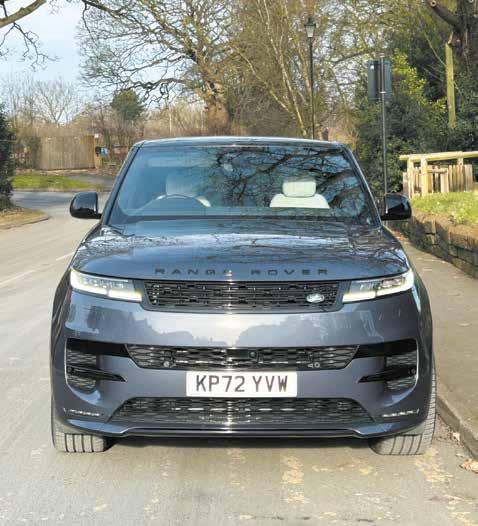
To clarify this, we had the plug-in for a week and when fully charged were able to amble around our local area for several days, using up the 50 miles of charge, before resorting to the petrol engine, which is brilliant. The car’s trip info showed that we were averaging 88.8mpg at that time. We then drove to Northumberland via the M6 and A66 taking in some breathtaking views between Barnard Castle and Hexham. A mix of motorway, dual-carriageway and then small B roads across the North Pennines saw the 155-mile journey return a figure of 38.7mpg, which we felt was impressive.
There’s no mistaking that with such a large battery on board, the Range Rover Sport PHEV is heavy: 2.8 tonnes, in fact. Somehow, though, it manages to feel a lot lighter than it actually is. The steering is nicely weighted and the tyres offer plenty of grip. Body roll is negligible even over undulating, narrow Pennine roads with switch-back corners.
In town driving in EV mode, it’s quiet and comfortable. On the motorway or in a straight line it’s highly enjoyable, and even if you push it as hard as we did in County Durham, it behaves impeccably. The eight-speed automatic gearbox feels refined and if you’re allowing the car to toggle between electric and petrol power, it’s all done serenely.
Talking of which, you can choose Hybrid mode, EV mode or save the EV mode for later. We did this on the motorway section, reserving the electric power for when we entered an urban area.

The adaptive cruise control and autonomous driving functions are simple to engage and operate and really come into their own for longer motorway travel. Forward progress is amazingly relaxing. Only the large external door mirrors allow a whisper of wind noise into the cabin. Our test car’s 22” wheels also did a good job of reducing the twitchy ride that can be caused by poor road surfaces. All-in-all, we had no complaints, especially with the glass
panoramic roof which allowed us to view a star-lit sky in light-free Northumberland.
Ridiculously low BIK of 5% means an annual company car tax bill under £2,000. Brilliantly built, incredibly comfortable and amazingly capable. The 50+ mile battery range is a game-changer.
The plug-in is expensive and you do lose almost 200 litres of boot space over the diesel version.
If you’re lucky enough to be able to choose a Range Rover as your company car, then the latest Sport P400e really is a no brainer. Nothing else bar the larger Range Rover PHEV comes close to its pure electric range, and with such low BIK you’ll save on the pennies, too. Furthermore, it’s as comfortable, capable and refined as you’d expect and as an added bonus looks-wise, it doesn’t shout too loud, either.
CC&V RATING:
Form an orderly queue: the BMW i4 eDrive35, has been added to the fully-electric BMW family.
Available in both Sport and M Sport trim, the four-door Gran Coupé offers a fully-electric range of up to 299 miles (WLTP), and features the same BMW Curved Display with BMW iDrive and Operating System 8 found in all BMW i4 models, as well as the BMW iX and iX1.
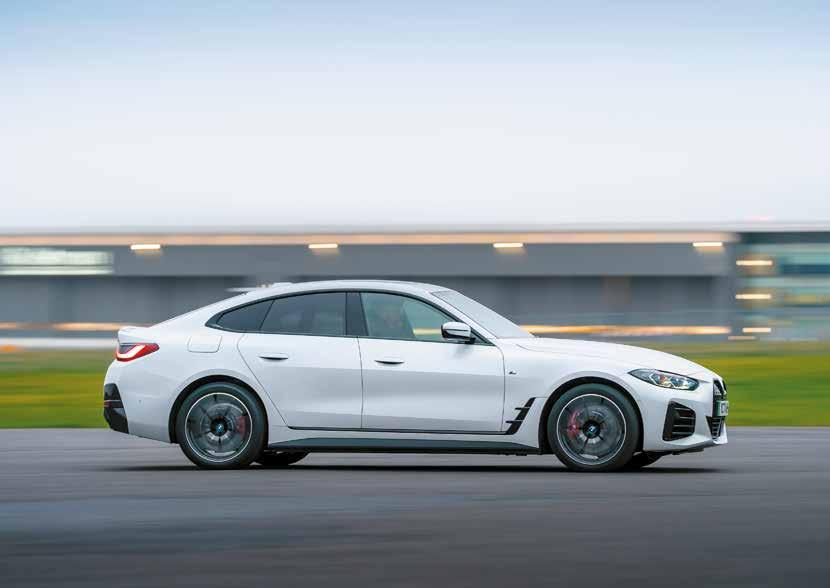
The BMW i4 eDrive35 Sport includes an impressive level of equipment as standard, including LED Headlights, 18” alloy wheels, as well as eye-capturing elements in blue design. Inside, Black Cloth/Sensatec upholstery is offered as standard with Front Heated Seats also included. Customers choosing the BMW i4 eDrive35 M Sport add the M aerodynamic exterior styling as standard, High-gloss Shadowline exterior, 18” M Aerodynamic alloy wheels, M Sport leather steering wheel and Alcantara/Sensatec interior upholstery with Black/Blue contrast stitching.
The BMW i4 eDrive35 is built at BMW Group Munich Plant alongside the eDrive40 and M50 models and it is expected that the production volume share of fully-electric cars at the plant will increase to 50 percent of the total manufactured volume in 2023.
BMW’s portfolio of fully-electric vehicles is continuing to grow, with BMW i5 set to join the BMW iX1, BMW i4, BMW iX3, BMW iX and BMW i7 later in 2023. The BMW Group is aiming for more than 50 per cent of its sales volumes to come from fully-electric vehicles no later than 2030. Last year in the UK, BMW
battery electric vehicle sales tripled on the previous year to 21,481 registrations, meaning one in five BMWs sold last year was a fully-electric vehicle, making it the fastest-

growing BEV brand in the UK.
Steve Roberts, General Manager, Corporate Sales, BMW UK, said: “Following the huge success we have seen with BMW i4 in the Corporate and Fleet markets since launch, we are very pleased to bring the eDrive35 model to the UK portfolio. We’re offering this model in Sport and M Sport trims, which both include an impressive level of standard equipment, including 18” alloy wheels, alongside a range of up to 299 miles. This latest model to join the i4 range will make electric driving accessible to even more of our customers.”
The BMW i4 eDrive35 is priced from £49,995 (OTR) and is available to order now in the UK, with expected delivery starting in summer 2023.
Power, poise and performance, all wrapped up in a distinctive BMW design – and offering a fully-electric range of up to 299 miles on the WLTP scale




Lexus has undertaken a complete reinvention of the RX SUV, building on the model’s great heritage and luxurious image and breaking new design and technology boundaries to increase the breadth of its capabilities and widen its prospective customer base.

Originally launched in 1998, RX model founded the market segment for luxury-focused SUVs. Since then, it has continuously evolved, notably becoming the first electrified model in the premium market with the 400h in 2005. Today, it is firmly established as a global core model for Lexus with 3.5 million sales –300,000 of these in Europe, almost 58,000 in the UK.
The all-new fifth generation model range will strengthen this position and Lexus’s reputation for design and technology excellence.
The design language for the new RX includes a new ‘spindle body’, achieved by integrating the signature spindle grille concept into the entire front of the vehicle. The RX team also drew inspiration from the model’s rich design heritage to produce a car that is instantly recognisable as RX, but with a more dynamic, elegant and confident character.
Inside, the driver-centred tazuna cockpit focuses on giving the driver direct, intuitive control of the vehicle, following the principal of ‘hands on the wheel, eyes on the road’. It also improves the driving experience, with its intuitive and clean layout, enhanced by the new Lexus Link Pro multimedia system with the ‘Hey Lexus’ onboard assistant, a 14-inch touchscreen and remote functions that can be accessed using the Lexus Link smartphone app.
To craft the new RX’s Lexus Driving Signature, Lexus optimised the SUV’s fundamentals such as the centre of gravity, inertia specifications, weight reduction, rigidity, and powertrain to create a more natural dialogue between car and driver. The improved handling and responsiveness are founded on a development of Lexus‘s GA- K platform that delivers excellent body rigidity and a low centre of gravity.
The new RX comes with a line-up of three different electrified powertrains. At the core of the brand’s offering in Western Europe, the RX 450h+ is the first RX to adopt Lexus‘s plug-in hybrid technology. The RX 350h hybrid electric is positioned as an efficient alternative to lower displacement diesel and petrol powertrains. And for customers seeking more exhilarating performance, Lexus is introducing its first performance-focused turbocharged hybrid, the RX 500h, which comes with Direct4 drive force control.
Leveraging Lexus’s world-class safety technology, the RX benefits from the third generation Lexus Safety System+, with an improved Pre-Collision System, new Proactive Driving Assist and an Extended Safety Package (Premium Plus Pack grade and higher). It is also available with Lexus’s Safe Exit Assist; linked to an electronic door release system, this prevents doors being opened into the path of vehicles or cyclists approaching from the rear.
The new Lexus RX is simply stunning
With a 2.5-litre plug-in hybrid electric powertrain, the 450h+ has a total system output of 304bhp/227kW. This translates into remarkable driving statistics: a 0-62mph in 6.5 seconds, CO2 emissions of 25-26g/km and fuel economy 235.4-256.8mpg.
The 2.5-litre hybrid engine is allied to a rechargeable lithium-ion battery with 18.1kWh capacity. An additional rear electric motor enables Lexus E-Four full-time all-wheel drive. While it offers similar power to the outgoing RX 450h, it produces more torque and faster acceleration. The battery’s size and capacity and Lexus’s electrification know-how combine to deliver significantly lower fuel consumption and emissions. CO2 emissions (WLTP combined cycle) are below 26g/km with fuel economy of more than 235mpg. The homologated EV driving range is 42 miles, with all-electric driving possible at speeds up to 80mph.
The Lexus plug-in hybrid system offers a critical benefit that sets the RX 450h+ apart from its rivals. When the battery charge is depleted, the vehicle switches seamlessly to its self- charging hybrid system, maintaining high fuel and emissions efficiency. This is in contrast to most other manufacturers’ systems, where the powertrain defaults to its internal combustion engine.
Lexus expects the RX 450h+ will be its core
RX model, a logical step-up for many of its current RX 450h customers and consequently the best-selling RX in Western and Central Europe.
However, therre will be a lot of interest in the RX 500h: a game-changing performance hybrid with a 2.4-litre turbo hybrid engine with six-speed automatic transmission and Direct4. The RX 500h is a breakthrough in hybrid electric technology that sets it apart from any Lexus hybrid model that has gone before. It is a model with a genuine performance edge, raising the RX’s appeal with customers who want high-end electrified performance.
It uses a completely new parallel hybrid architecture, featuring a turbocharged 2.4-litre turbo petrol engine and six-speed automatic transmission, integrated front motor and power control unit, hybrid battery and a compact 76kW rear e-axle.
Total system output is 366bhp/273kW with 550Nm of torque, giving 0-62mph acceleration in 6.2 seconds.
The front electric motor is positioned between the engine and the transmission (which has a clutch on both sides), enabling great flexibility in power delivery and the ability for the vehicle to run in all-electric EV mode. The hybrid control system automatically switches between
The total system output is 366bhp/273kW, acceleration is 0-62mph in 6.2 sec and the CO2 are emissions are182-189g/km.

Lexus Guildford is an award-winning business, working as part of the Inchcape PLC Group.
Lexus is renowned for delivering exceptional customer care. Whether that be at the point of purchasing and taking delivery of your new car, or whether you are visiting for some routine service work, you can expect to receive the best level of service within the industry.
This is a statement reflected in the numerous awards won in consumer surveys, year upon year.
Lexus Guildford is proud of the continued positive praise for their contribution towards these awards and is happy that its site was recognised with the prestigious Kiwami award for being one of the best retailers in Europe.
Lexus Guildford has recently appointed Steph Dyson as its Local Business Development Manager to help guide those looking for company cars through the Lexus range. Steph is dedicated to ensuring the service offered is consistent and in line with that of the retail operation. She has worked at Lexus Guildford as part of the management team for five years, and previously she has also covered roles within the after-sales and retail sales teams within the motor industry, with a total experience of 15 years.
She said: “I have always had a passion for ensuring we deliver the right outcome for our customers. I fully believe that Lexus offers something that no other manufacturer has been able to achieve in terms of product reliability, customer service, and overall quality.
“We are now able to offer a varied range of vehicles, so there is something for everyone.”
This year Lexus has four new amazing models added to the range, which all appeal to the corporate network as they enjoy Plug-in Hybrid or BEV technology; this allows end
users to enjoy lower BIK rates and supports companies in their goals to reduce their impact on the environment and their carbon footprint.
Lexus NX 450h+

This vehicle offers striking looks, breakthrough hybrid powertrains and exhilarating performance, making the NX more desirable than ever. NX 450h+ benefits from low BIK taxation from only 8% while an EV driving range in excess of 40 miles enables all-electric driving at speeds up to 83 mph.
Packed with intuitive technology, NX 450h+ enhances your driving experience with beautifully finished interior, premium acoustics and Lexus Safety System + as standard.
The All-New RX450+ is another newcomer. The largest SUV-style vehicle we offer within the Lexus range, the very first retailer demonstrators are now with us, so customers can experience all this car has to offer. We expect this vehicle to be very popular within the corporate market.
The RX has a lighter, more rigid platform, a lower centre of gravity and new multi-link rear suspension than its previous model. The result is consummate power, extraordinary comfort and refinement, and an exceptionally rewarding driving experience. The RX remains a true icon on the road.
New features include a coupé-like roofline with a signature black rear pillar. To the rear, the single-line LED Lexus signature light emboldens the car’s stance and road presence. New and exciting hues capitalise on the stylish appearance. Again, this vehicle having a plug-in hybrid option can benefit from a low rate BIK rate of only 8%.
Lexus UX250H & 300E
The fourth generation Lexus Self-Charging Hybrid, Lexus UX250H compact SUV
combines fuel efficiency with smooth performance. The result is a car with a unique presence on the road. This vehicle offers impressive fuel consumption ranging from 46.3-53.2 mpg. Lexus has also introduced an all-electric UX – the UX300E. The enhanced model now offers an increase on the range of 40%, which means you can now enjoy up to 250 miles of driving before charging the vehicle. Again, a great offering for a company car with a BIK rate of only 2%.
The all-new Lexus RZ450
The most eagerly anticipated new model to the Lexus range is the all-new Lexus RZ450. It’s the first dedicated fully electric vehicle to arrive in the Lexus range, and Steph said she was fortunate to enjoy a sneak preview during a recent Lexus training event. “I am so excited for this vehicle to arrive. We have orders already in for this car, and I just know this will be very popular in the corporate world.”
She added: “It is incredible to drive. You can tell that this car is something special. Unlike some other EVs, where the car has been converted from a traditional combustion or hybrid model, the Lexus RZ450 has been designed from the ground up to be fully electric. It really is superb, and I think this model is going to be very popular going forward.”
Whether you select a Lexus Self-Charging Hybrid, Plug-In Hybrid or All-Electric vehicle, you can expect an exceptional electric driving performance and superb fuel efficiency, along with an array of luxurious Lexus touches as standard – including Apple Car Play® or Android Auto®, and Lexus Safety System +. There is also a leading warranty package of 10 years or 100,000 miles, which just demonstrates the overall confidence in the quality of the Lexus product.
Do we need another small SUV? Volkswagen obviously thinks so, which is why it’s introduced the Taigo, a new crossover that sits above the T-Cross and below the T-Roc in the Volkswagen car range.
It’s available with a 1.5-litre petrol engine and two smaller 1.0-litre petrol engines. There are also three trim levels: Life, R-Line and Style.
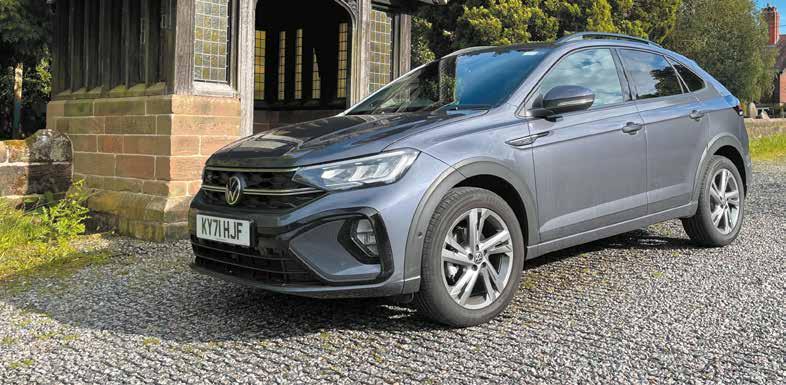
The smaller of the two 1.0-litre engines produces 95hp model, and is only offered in Life trim in five-speed guise. The more powerful 1.0-litre is a six-speed and produces 110hp, and is available on all trims.
In addition there are two auto boxes: a 1.0 litre seven-speed 110hp across all the range, and one for the 1.5 litre 150hp engine, on just R-Line and Style trims.
Spec
It’s well appointed. Life comes with LED headlights, 16” alloys, black-painted roof rails, an 8” digital driver’s display, wireless phone charging, adaptive cruise control, plus front and rear parking sensors.
The R-Line adds 17” alloys, tinted rear windows, R badging, black roof lining, an R Line steering wheel, dual-zone climate control, a 10.25” digital driver’s display and an 8” touchscreen infotainment system with SatNav, while the range-topping Style model adds a full-width LED light bar in the front grille and automatic headlights. All models also feature lane assist, traffic-sign recognition, autonomous
Solid contender: Drives and handles well and great equipment levels. Good looking and a clever addition to the VW family.
CC&V RATING: N N N N
emergency braking, plus the bonus of wireless Apple CarPlay and Android Auto connectivity.
Exterior
There’s bit of a 1990’s Scirocco there, as the Taigo is lower and longer than a T-Cross. Up front, there’s a large VW logo sitting centre grille, with narrow headlights and deep set fog lights. The side is neat and tidy whilst the rear features high set headlights at each corner, low set bumper lights and a sloping rear hatch.
Logically laid out instrumentation, a large, central touchscreen, steering wheel controls for infotainment and adaptive cruise control and separate climate controls. There’s also a proper handbrake and gear lever finishing things off.
The quality is mixed, with the good stuff located higher up on the dash front and top, but cheaper plastics adorning the door pockets and centre binnacle. The seat fabric looks and feels built to last, however.
The EURO 6 engine comes with 134g/km of CO2 emissions and a combined economy of 47.8mpg. A week behind the wheel saw us average 44.6 mpg, so not far off the claimed. The 40-litre fuel tank will cover 350-400 miles.
Our R-Line 1.0-litre three-cylinder TSI turbocharged petrol engine delivered 108bhp and 200Nm of torque, which is plenty for a car weighing 1,260kg. The seven-speed DSG gear box is more than up to the job, and shifts swiftly and smoothly through the gears.
The 0-62mph time is 10.9 seconds, with enough oomph offered for most situations. Top speed is 119mph, although we didn’t get close, sticking to 70mph in cruise control when on the motorway. Volkswagen’s steering wheel controls are simple to use when setting adaptive cruise up and you can also adjust your distance to the vehicle in front via the steering wheel controls.
The engine was mostly quiet, only becoming noisy when you put your foot down hard. In town the auto box makes driving the Taigo a cinch and it’s smallish proportions make for easy parking.
On winding roads you’ll enjoy the light steering and Taigo’s clearly very able around corners. Ride quality is also very good, with only the worst road surface causing any distress.
Pros
The Taigo is a handsome, five-door family car, with coupé looks that make it stand out in crowd. All models are extremely well equipped and feature top-notch tech and safety. The 440-litre boot and hatch entry make it practical, too, and will offer plenty to those looking for more than a run-of-the-mill family car.
Cons
The arrival of another VW SUV may confuse some, and the lack of a plug-in variant seems odd at this point in time.
Conclusion
The Taigo drives and handles well. We’d choose a Life model fitted with the 1.0 litre 6-speed manual 110hp engine as a car this size doesn’t require an automatic gear box and you’ll save a bit up front and at the pumps.
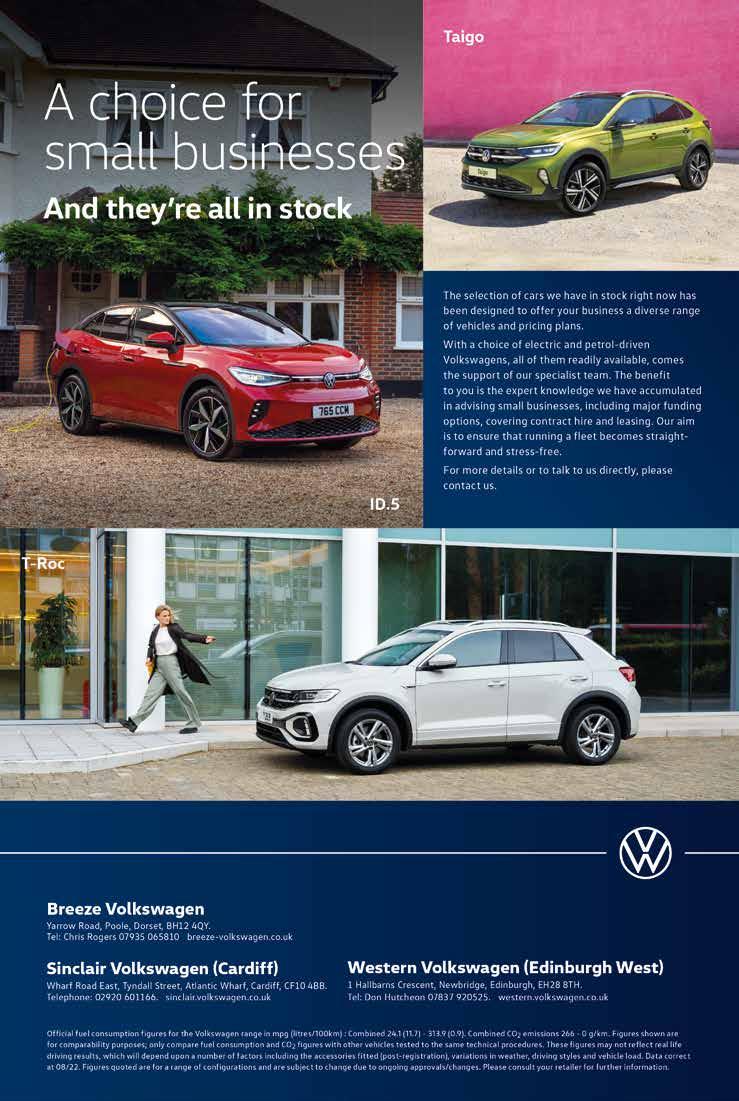
The all-new Ford Ranger Raptor is the exciting new generation of Europe’s market-leading pick-up. Now in its second generation, it raises the off-road performance bar and embodies the smarter, tougher, more capable character present in every new-generation Ranger.
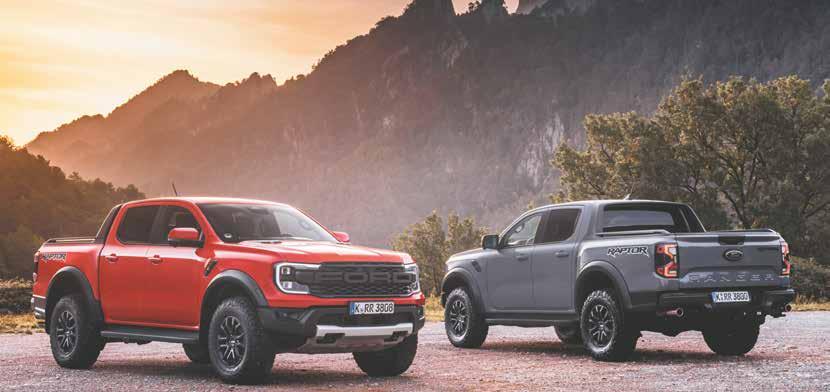
Developed by Ford Performance, the all-new Ranger Raptor is the ultimate derivative of the latest Ford Ranger. With smarter technology controlling tougher, next-generation hardware, Ranger Raptor blends raw power with mechanical and technical precision to create the most advanced Ranger ever.
“We’ve really focused on delivering a genuine performance truck with the all-new Ranger Raptor,” said Dave Burn, Ford Performance chief programme engineer for Ranger Raptor. “It’s significantly faster, looks incredible, is packed with new features, and it’s the toughest Ranger we’ve ever made.”
The biggest news for performance fans is the introduction of an all-new twin-turbo 3.0-litre EcoBoost V6 petrol engine tuned to produce 292PS and 491Nm of torque.
The twin-turbo 3.0-litre EcoBoost V6 engine boasts a compacted graphite-iron cylinder block, which is around 75 per cent stronger and up to 75 per cent stiffer than the iron used in traditional castings.
“The 3.0-litre engine brings a different dynamic to the Ranger Raptor that will satisfy even the most hardcore performance enthusiast,” Burn said. “The acceleration and raw performance of the new powertrain leave you grinning from ear-to-ear.”
The all-new Ranger Raptor has a unique chassis frame and suspension compared to other Ranger variants. A series of Raptorspecific mounts and reinforcements for
elements including the C-pillar, load box and spare wheel, as well as unique frames for the jounce bumper, shock tower and rear shock bracket all combine to ensure the ultra-tough pick-up can handle punishing conditions.
A high-performance off-roader like the Ranger Raptor needs the running gear to match, so Ford engineers completely redesigned the suspension. All-new tough yet lightweight aluminium upper and lower control arms, long-travel front and rear suspension and a refined Watt’s link rear end have been designed to deliver more control across rough terrain at high speed.
Ranger Raptor’s ability to tackle rough terrain is further enhanced with some serious
Matching the enhanced capability of Ranger Raptor is an all-new look that builds on the nextgeneration Ranger’s bold, strong style. Flared wheel arches and C-clamp headlight designs emphasise the pickup’s width, while bold F-O-R-D lettering on the grille and the tough separate bumper add more visual muscle.
Customers can choose from seven exterior colours, including striking, Raptor-unique Code Orange or Conquer Grey that reaffirm the pickup’s exclusivity and performance. For even more visual punch, Ford offers Raptor splash decal graphics that add race-inspired character.
The matrix LED headlights with LED daytime running lights push Ranger Raptor’s lighting performance to new levels, featuring predictive curve lights, glare-free high beam and auto dynamic levelling to deliver better visibility for Ranger Raptor drivers and other road users.
The flared fenders cover muscular 17-inch alloy wheels wrapped in Raptor-exclusive performance all-terrain tyres. Functional vents, aero features and tough, grippy cast-aluminium side steps help enhance the look and functionality of the truck.
underbody protection. The front bash plate is almost double the size of the standard unit, at 2.3 mm-thick, and is designed to protect key components.
Ranger Raptor adds an advanced full-time four-wheel drive system with an all-new electronically-controlled on-demand two-speed transfer case. The Raptor offers both front and rear locking differentials, with the new front differential providing a valuable additional feature for off-road use.
At the rear, LED taillights provide a signature styling link to the front, while the Precision Grey rear bumper features a central step pad and a towbar that is tucked up high to avoid compromising the departure angle.
Inside, the cabin features all-new sports seats to increase comfort and offer more support during high-speed cornering.
It also features the latest digital technology; the high-tech cabin has a 12.4-inch all-digital cluster and 12-inch centre touchscreen with Ford’s new-generation SYNC 4A® connectivity and entertainment system that delivers wireless Apple Carplay and Android Auto™ compatibility at no extra cost.
The 3.0-litre engine brings a different dynamic to the Ranger Raptor that will satisfy even the most demanding of owners
‘‘ ‘‘

Range-topping new Ranger Platinum version of the region’s market-leading pick-up sets a new standard for luxury in the segment

The new Ranger Platinum joins the exciting next-generation line-up of Europe’s best-selling pickup 2 at the pinnacle of the on-road range. Exclusive exterior detailing and finishes enhance the Ranger’s already characterful design, matched by a stylish and contemporary leather-trimmed cabin.
Ford’s powerful 240PS 3.0-litre V6 turbodiesel engine and a drivetrain specially engineered for refinement combine to deliver smooth, effortless performance for cruising, as well as exceptional torque for confident load carrying and towing up to 3,500kg. 3
“The Ford Ranger has set the standard for performance, versatility and capability in the pickup segment, and now it’s setting the standard for luxury. The stunning new Platinum will suit customers who appreciate the level of comfort and technology from high-end road cars, but who rely on the toughness and all-round productivity that consistently make Ranger Europe’s pickup sales leader,” said Hans Schep, general manager, Ford Pro, Europe.
Ford Pro’s most luxurious Ranger yet Ranger Platinum is available exclusively in five-seat, double cab specification, and powered by Ford’s 3.0-litre V6 turbodiesel engine, producing 240PS and 600Nm of torque. Power is delivered through the Ranger’s new electronically controlled full-time all-wheel drive system, combined with Ford’s
10-speed automatic transmission with adaptive shift scheduling and mounts re-engineered to reduce noise and vibration.
The result is refined, responsive performance regardless of conditions, and a generous maximum braked towing weight of 3,500kg. The vehicle also offers the same outstanding load-carrying ability as all Ranger pickups, including a payload exceeding one tonne.
The Ranger Platinum exterior builds on the muscular and functional styling of the Ranger pickup family with added sophistication. The new model sits above the high-series Wildtrak – which accounted for 60 per cent of outgoing Ranger model sales in Europe.
A unique grille and new silk chrome finish for Ranger Platinum’s exterior highlights help deliver a striking first impression, supported by new 20-inch machined-face alloy wheels with high-gloss ebony detailing. Further premium touches include a soft-close tailgate, privacy glass and signature daytime running lights within the matrix LED headlamps. Standard roof rails add a purposeful look and extra practicality.
Inside, Ranger Platinum blends a luxurious leather-trimmed cabin with clever tech designed to make life easier. The driver and front passenger benefit from premium perforated and quilted leather seats with 10-way power adjustment, heating and cooling functions, and stylish contrast stitching. Open-grained dark maple wood textures continue the opulent design, and sophisticated ambient interior lighting helps create a calming atmosphere.
The high-tech cockpit is defined by dual 12-inch screens; a full digital cluster replaces
the traditional gauges ahead of the driver, alongside a portrait touchscreen controlling Ford’s powerful SYNC 4A infotainment system. Ranger Platinum also features an eight-speaker B&O audio system and wireless device charging as standard. Powerful connectivity is delivered by a standard FordPass Connect modem, which enables multiple modules to be wirelessly future-proofed via Ford Power-Up software updates that can improve the vehicle over time.
In addition to the comprehensive advanced driver assistance systems on Ranger Wildtrak, the Platinum series also features Active Park Assist with Park Out Assist, Blind Spot Information System with Cross-Traffic Alert and Trailer Coverage, Lane Change Warning & Aid, and a 360-degree camera as standard equipment.
The Platinum series tops the widest ever range of Ranger pickup variants available from Ford Pro, and in addition to the highperformance Raptor and Wildtrak models that are already on sale, customers can now also order the rugged XL trim, priced from £27,550 excluding VAT for the single chassis cab, £28,275 excluding VAT for the single cab variant and £29,800 excluding VAT for the double cab; and XLT, available in double cab only, priced from £31,150 excluding VAT.
These iterations feature no-nonsense specifications to suit commercial users such as those in construction, forestry and the emergency services.
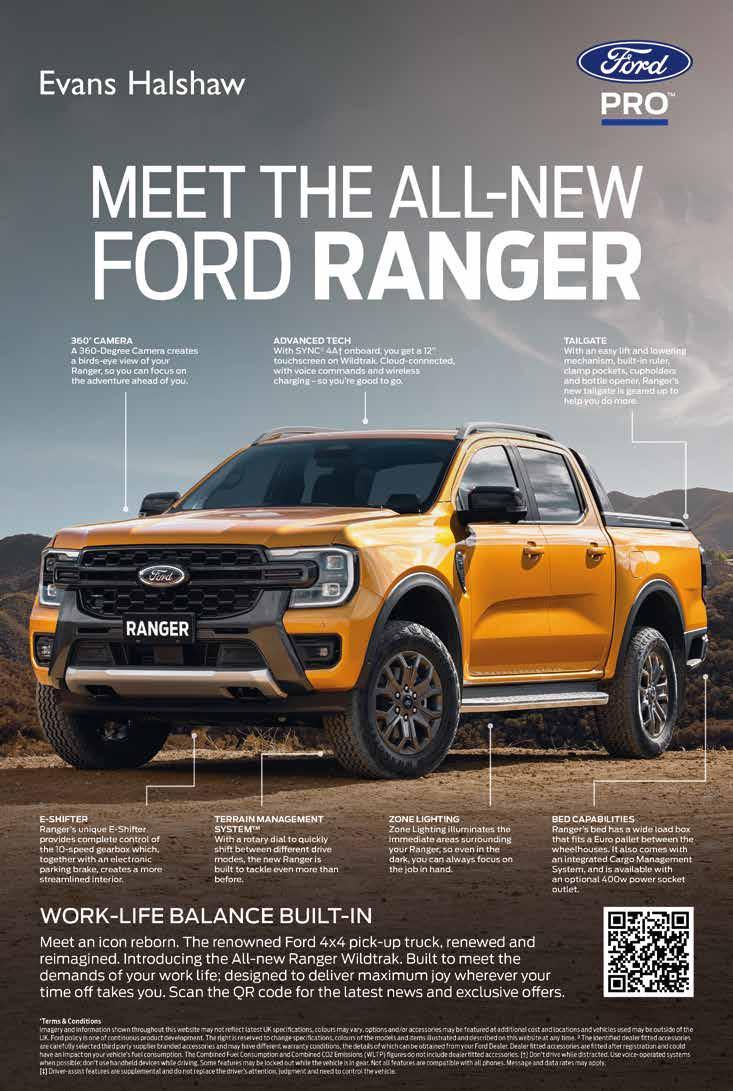
Company Car & Van spent an informative day at Toyota’s Burnaston plant recently, touring the manufacturing floor before testing out the updated Corolla Commercial. It’s a model that is developed and produced here in the UK, with Corolla’s home-grown links including its engines, which are supplied by the TMUK Deeside factory in North Wales. Andrew Walker takes up the story.
Fitted with a new fifth generation hybrid electric drive train, the 2023 Corolla Commercial features an all-new 1.8-litre self-charging powertrain, that delivers more power while preserving its high efficiency.
The system’s principal components have been comprehensively redesigned to save weight, reduce losses and improve performance –changes that include the introduction of a more powerful lithium-ion battery. The new battery is smaller and 14% lighter than before, while increasing power by 14%.
Corolla Commercial gains the latest Toyota
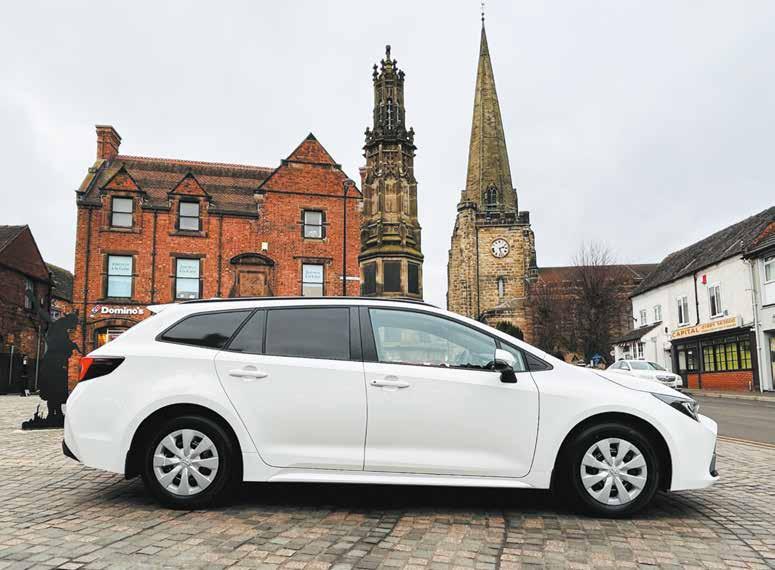
Safety Sense package of advanced safety and driver assistance systems, with more functions and increased hazard detection capabilities.
The inside remains unchanged and includes a rubber load space lining, full bulkhead grille, interior light and 12v power outlets.
Load-carrying capacity is maintained at 1,326 litres with 425kg maximum payload and 750kg towing capability.
Squint hard and you may notice the subtle exterior changes, with a new bottom to the front bumper, redesigned headlights and new combo rear lights.
Total power from the 1.8-litre system is now 138bhp, bringing a 1.7-second reduction in the 0-62mph time to 9.4 seconds. CO2 emissions are from 100g/km, with fuel economy from 64.2mpg (all figures WLTP combined cycle).
Available in a single grade with a standard equipment specification, key features include, multimedia system with 8” display and voice recognition, Apple CarPlay and Android Auto, Toyota Safety Sense, over-the-air updates for
multimedia and safety system software, dual-zone automatic air con, heated front seats with power lumbar adjustment, a reversing camera and automatic headlights.
Safety is to the fore in the updated and improved Corolla Commecial with a new front camera. Forward detection has been doubled compared to the previous hardware as has the coverage of the front millimetre-wave radar.
The Pre-Collision System is now more effective. Among its improvements is its ability to recognise potential head-to-head collisions, while the Intersection Collision Avoidance system can now identify approaching traffic across two lanes, as well as cyclists and vehicles approaching from the side.
Emergency steering assist helps the driver keep the car within its traffic line and you also get a new Acceleration Suppression Function.
The Adaptive Cruise Control has been revised to give faster response and you also benefit from Overtake Prevention Support, which prevents unintentional overtaking on the wrong side of a vehicle.
Other functions include Preliminary
Deceleration, Lane Trace Assist, Deceleration Assist, Proactive Driving Assist and Obstacle Anticipation Assist.
Warranty
As part of the Toyota Professional range of LCVs, the Corolla Commercial is eligible for five years’ free roadside assistance, 10 years or 100,000 miles Toyota manufacturer’s warranty, followed by up to a further seven years’ of service-activated warranty. For the first three years of the car’s life, owners can have it serviced at a place of their choice. When the new car warranty period expires, they can then benefit from an additional 12 months (or 10,000 miles) warranty when their vehicle has a qualifying service at an authorised Toyota workshop. The warranty is provided at no extra cost, up to a limit of 10 years/100,000 miles.
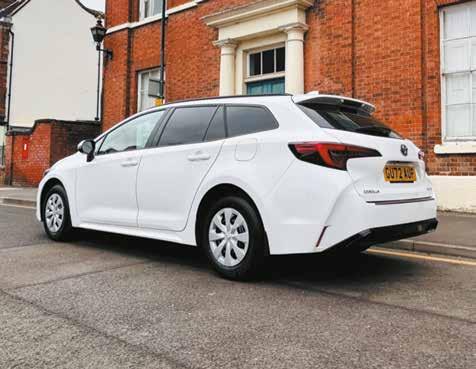
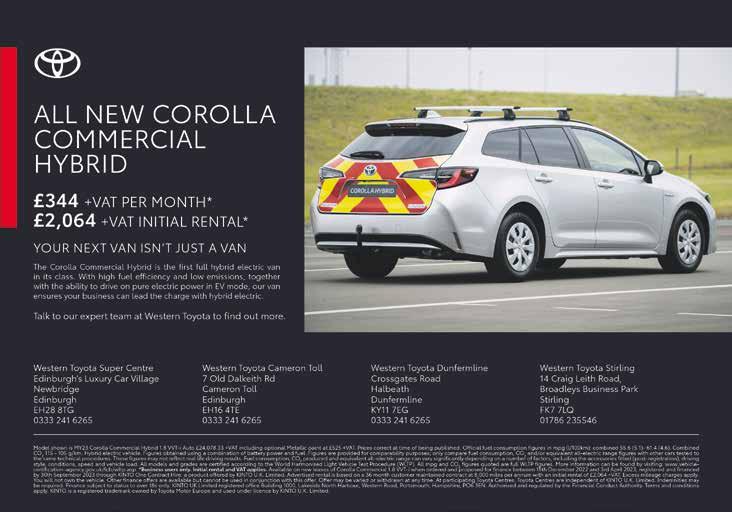
Driving modes and regeneration
Choose from Eco, Normal or Sport driving modes, with the former increasing your range, the latter adding more sparkle to your ride. Using the gear lever, the usual suspects, Drive, Reverse and Neutral are joined by B, for brake regeneration. Simply pull the centrally mounted gear lever all the way back past D and hey presto, you’re able to utilise the on-board regeneration. And it works, adding a heavier touch to the accelerator. Switch to Drive and the CC lightens up, for smoother progress.
Continued on pg 38
Choose from Eco, Normal or Sport driving modes... the former increases your range, the latter adds a touch more sparkle to your ride... with Normal in the middle ‘‘
Continued from page 37
We spent a couple of hours driving the improved Corolla Commercial over a mix of roads, and what’s abundantly clear from the start is that the more powerful engine and smaller lithium-ion battery have vastly improved the way the Commercial drives.
We drove the Corolla Commercial in 2022 and while we highly rated it, the CVT gearbox was always an issue. What Toyota has managed to achieve with the improved 1.8 engine is that the throttle and vehicle response are now far more consistent.
Gone is the whining elastic band feeling of old, replaced with a much smoother gear change and better acceleration.
This has been achieved by calibrating the throttle better to suit familiar driving scenarios, such as stop-start traffic and frequent changes in speed limits. The acceleration also adapts to up and downhill driving, synchronising the engine speed with the driver’s inputs to give a more natural feel and easier drive.
Running at lower rpm also makes the system quieter when driving at highway speeds. With my iPhone linked wirelessly to Apple Car Play, this allowed me enjoy my podcasts and even make and take a couple of hands-free phone calls.

Our test vehicle, when full, indicated a range of 570 miles, a full 400 miles more than the best electric van can muster and the main reason for the CC’s existence. Chances are that by regularly using the Corolla’s brake regeneration and the electric range in town, you’ll top 600 miles. From where we’re based in the north
west, we could happily drive to London and back, 420 miles, and have fuel to spare. No stopping to charge and no range anxiety and a similar range to many small diesel vans. Toyota quotes a WLTP economy figure of 64.2mpg and that is another reason to like the CC.
Pros
Excellent 500-600 mile driving range. Comfortable car derived cabin and ride make journeys relaxing. Decent storage capacity. Cleaner than a diesel. Much less to lease than
an EV with a much smaller deposit required than an electric van.
Cons
Cargo capacity can’t match that of the Fiesta van’s 0.96 cubic metres or the larger Toyota Proace City’s 3.3 cubic metres
Conclusion
The new engine has taken away the one thing we didn’t like about the Corolla Commercial, the whining CVT gearbox, which is no more! You now have a much-improved and well-rounded vehicle to drive everyday. The addition of Toyota Safety Sense means you’ll be driving an incredibly safe vehicle as well. And for those who need a load carrier that offers green hybrid motoring without the range anxiety, charging time and cost of an EV, it’s unbeatable!
The Corolla Commercial ticks an awful lot of boxes as far as the driver is concerned: safe, comfortable, good to drive and with no range anxiety.
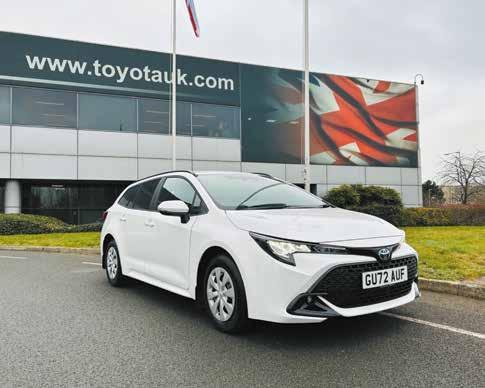
CC&V
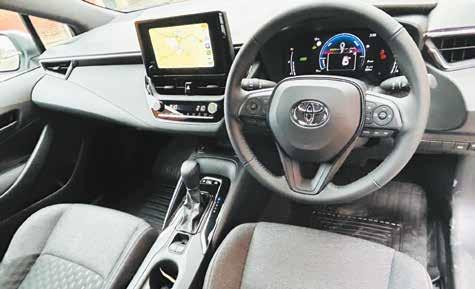
‘Gone is the whining elastic band feeling of old, replaced with a much smoother gear change and better acceleration... the one thing we disliked about the old Corolla Commercial has been vanquished...’
Marshall Toyota Stourbridge is pleased to confirm that Ben Kyle has been promoted to Business Centre Manager for the Midlands areas, covering the territories of Stourbridge, Worcester, Hereford and Bromsgrove.

Ben has been part of the team for four years and has been an influential member of the sales team, helping to drive the dealership’s growth.
Iain Sercombe, General Manager for the Midlands Area, shared the news and was delighted to see this internal promotion. “It is always great to see colleagues like Ben get recognition for their outstanding performance and commitment to their job role.
“Ben is someone who has been at the heart of the development of the Midlands Area for some time now and he now gets his opportunity to lead the department.”
Ben will look after commercial customers offering fleet solutions to all types of businesses, with a wide choice of finance funding options and a range of Toyota models, including our highly advanced self-charging hybrid, plug-in hybrid and all-electric vehicles.

He told Company Car & Van: “I am so pleased to be taking on this new role and leading the fleet team in an exciting direction. Representing such an amazing brand is a real
pleasure and I truly believe Toyota have one of the best offerings to business customers.”
He added: “Toyota has been leading the way with alternative fuel vehicles for years, which puts us in a strong position going forward with the motor industry going through such a significant period of change.”
Marshall Toyota also has Business Centres in Bristol, Cardiff, Gatwick & Tunbridge Wells, all offering the full range of Toyota cars and commercial vehicles for your business.
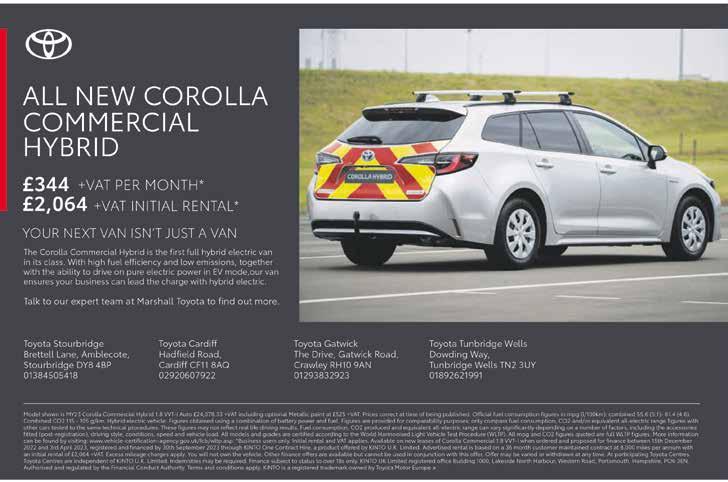
Boasting a sharp new design and a stylish interior, the new Mercedes-Benz Citan panel van is already delighting customers in the UK, with more variants, including a crew van and electric models, available later in the year.

Mercedes-Benz vehicles are renowned for their exacting safety credentials and premium specifications. The Citan is no exception, with standard specifications including Active Brake ASSIST with pedestrian recognition technology; ATTENTION ASSIST, which detects drowsiness in the driver and encourages them to take breaks when tired; and Hill-Start ASSIST to prevent rolling back.
There’s also a speed limiter, an emergency breakdown assistance call button, rear parking aid with a reversing camera and no fewer than six airbags. Blind Spot ASSIST, Active Lane Keeping ASSIST and Speed Limit ASSIST can all be specified as options.

As with all Mercedes-Benz vans, the new Citan comes with a three-year, unlimited mileage warranty and free, round-the-clock roadside assistance. Managed and operated by Mercedes-Benz franchised dealers, this award-winning service is free for three years on all new vans and renewed every 12 months after this period, when serviced at an authorised Mercedes-Benz workshop, for up to 30 years. Known as MobiloVan, it covers accidents, breakdowns and a number of minor mishaps and driver errors – from running out of fuel or using the wrong fuel to flat tyres, lost keys and attempted theft or vandalism in the UK and across Europe. The Citan also includes anti-theft protection in the form of double locks and an integrated alarm system. Mercedes me connectivity as standard means that real-time vehicle data can be accessed remotely via a smartphone app to help optimise uptime, safety and security. Features include over-the-air software updates, access to vehicle monitoring in the event of theft. Fuel levels, mileage and remote
door-locking functionality can also be checked via the app. The potential benefits for operators were clear to judges who named the new Citan joint winner of the International Van of the Year title for 2022.
Multimedia functions, including a seven-inch touch screen and a multimedia system with ‘Hey Mercedes’ voice assistant and smartphone integration via Android Auto or Apple Carplay are standard features on all Citan trim lines.
Both L1 and L2 versions of the Citan are powered by the same 1.5-litre diesel engine, which generates 95 hp and 260 Nm of torque, and delivers WLTP combined fuel economy of 54.3 mpg, helped by the ECO start/stop function. Drive is to the front wheels via a six-speed manual or optional seven-speed automatic transmission. Fully electric eCitan variants, with zero tailpipe emissions, will follow at a later date.
Two trim levels will be available, PROGRESSIVE and PREMIUM, both with comprehensive equipment offerings. All Citan cab interiors boast heat-insulating glass all round and multi-function steering wheels that adjust for both rake and height. Exterior design touches include 16-inch wheels (design
There is a three-year unlimited mileage warranty available on every new van, and in addition, Citan owners will be able to access the most comprehensive Aftercare package on the road – for businesses that demand more.
The Mercedes-Benz 120-strong Dealer network works around the clock to service and maintain your vans and keep your business moving. It all adds up to more value, more flexibility and more confidence that you’ll only find at an authorised Mercedes-Benz Dealer. Book your service online or by telephone, and as well as a standard ‘drop and go’ service with a courtesy van, you’ll also get:
• Early bird, late night and weekend slots
• Collect & deliver service
• Mobile service
• Express 1hr service
• Overnight service
• Electric van service.
Citan
110 Van L1 Progressive
Price: £21,310 (ex VAT)
Payload: 667kg
CO2 : 137g/km
Combined WLTP: 54.3
wheels on the PROGRESSIVE and alloys on the PREMIUM) and heated, electrically adjustable side mirrors.
PREMIUM adds a range of cosmetic enhancements including body-coloured bumpers, chrome trim, gloss black dashboard finish, a Dynamic exterior package with metallic paint and unique alloy wheels and a Light package, which comprises LED high-performance headlights with High Beam Assist and front foglamps.
The Citan L1 has a load length of 1,806 mm and a payload capability of 667 kg in PROGRESSIVE form, with a 666 kg payload for PREMIUM vehicles. Both are rated to tow trailers up to a maximum gross train weight of 3,500 kg.
Mercedes-Benz Vans UK Sales Director Sarah Palfreyman said: “In the new Citan, van operators have a vehicle that exemplifies all the renowned Mercedes-Benz virtues of reliability, safety and cost-effective performance, backed by a national network of dedicated Dealers who provide the highest standards of customer care. It’s much more than just a great small van, though.
“The services available through Mercedes me once again demonstrate that we’re dedicated to supporting our customers by doing all we can to keep their businesses moving.”

The successor to Nissan’s hugely successful e-NV200, the Townstar, is primed to futureproof business operations and accelerate the transition towards electrification.
Key to its appeal, however, will be the fact that it offers two highly advanced powertrain solutions – one petrol and one fully electric, in combination with the latest driving technologies.
For customers looking towards zero emission motoring, prices will start from £29,945* for a short-wheelbase Townstar equipped with a 45kWh battery, with a range of up to 183 miles WLTP combined or up to 269 miles in city cycle.
Alternatively, a refined 1.3-litre TCe petrol unit is also available and is fully compliant with the latest Euro 6d-Full emissions regulations, delivering 130HP of power and 240Nm of torque, offering power and efficiency in equal measure. Petrol versions of Townstar start from £19,475.
Townstar brings a suite of 20+ technologies to the compact van segment and will feature a broad range of safety technologies and advanced driver assistance features such as Intelligent Emergency Braking, Hands-Free Parking, Intelligent Cruise Control and Around View Monitor (AVM), exclusive to Nissan, putting it at the forefront of its category.
The exciting line-up comprises four generously-specified trim levels: Visia – well equipped and ready to work; Acenta – featuring enhanced facilities to accommodate most professional needs; Tekna, incorporating additional driver convenience and exterior styling; and Tekna+, combining the very latest
technology with enhanced driver assistance. When it comes to carrying capabilities, Townstar provides a generous payload of up to 600kg (SWB) or 800kg (LWB). In addition, the maximum braked towing capacity is 1,500kg.
Allan Newman, LCV product manager at Nissan GB, said: “We’re delighted to be providing more information about all-new Townstar as its arrival in the UK approaches. Offering two efficient powertrain solutions, practical design and unique Nissan

Electric versions of the all-new Townstar are priced from £29,945 and will come with an 11kW (Visia grade) or 22kW AC (Acenta grade on) on-board charging system which will be class-leading in its segment. As with its e-NV200 predecessor, there will also be a DC rapid charging connector standard from Acenta grade, which can recharge the battery from 0% to 80% in a little over 40 minutes.
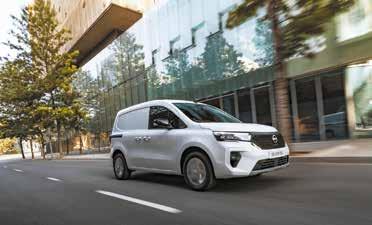

Prices for all-electric short-wheelbase examples range upwards to £34,845 for a Tekna+ model. Long-wheelbase all-electric Townstar varies in price from £31,245 (Visia) to £35,845 (Tekna+).
Petrol versions:
On petrol versions, the aforementioned £19,475 price tag applies to a SWB Visia trim-level vehicle, powered by Nissan’s 1.3-litre TCe petrol engine and with a six-speed manual transmission.
technologies, it is comprehensively equipped to meet customers’ ever-changing needs.
“With tougher emissions standards, urban access restrictions, and ever-increasing demand for last-mile delivery, businesses large and small need to find effective and sustainable solutions to remain competitive and optimise their operations.
“We’re confident Townstar will meet their every need.”
The most expensive short-wheelbase petrol-powered Townstar, in top-of-the-range Tekna+ specification, comes in at just £23,125. Turning to long-wheelbase petrol options, prices range from £20,775 (Visia) to £24,425 (Tekna+).
Furthermore, this is backed by a panEuropean five-year or 100,000-mile warranty, in addition to the eight-year or 100,000 miles battery warranty for the EV version. This includes bumper-to-bumper protection, genuine parts and accessories and roadside assistance – providing comprehensive cover for extra peace of mind.
For customers looking towards zero emission motoring, the short-wheelbase Townstar has a 45kWh battery with a range of up to 183 miles WLTP or 269 miles in city cycle

The ID.Buzz Cargo is the first all-electric van from Volkswagen Commercial Vehicles. It’s built on the MEB Platform that also features on the company’s ID. car range, but what makes it really stand out is that it has been designed with more than a nod to the classic Type 1 VW panel van from 1949, meaning it has a truly retro look.

There are two models to choose from, the Commerce and the Commerce Plus, with prices starting at £46,621 including VAT
Exterior
In a world of bland vans – after all, how do you make a box on wheels look good? – the Buzz Cargo is refreshingly different. At the front the Cargo has high LED headlights, with a slim lateral bar joining these with the large VW logo in the middle. Beneath this sits a honeycomb grille. The sides are smooth and flat, while the rear double doors also feature a mid-height light bar and narrow corner LED rear lights. There’s also large VW logo on the left hand door facing the ID. BUZZ lettering.
Interior
ID. Buzz Cargo launches as standard with three seats in the cab: driver’s seat plus double bench seat. If you don’t want the bench, you can option a single seat for the front passenger. There’s a fixed bulkhead behind the seats and this too can be personalised with a window or a hatch.
The dashboard layout, fixtures and fittings will be familiar to existing Volkswagen customers. All of it is exceptionally well made, looks good and feels durable. The main colour options are dark grey, black and chrome. The centrally located 10” infotainment touchscreen sits neatly in the centre on what is a very uncluttered dashboard.
Haptic climate controls lifted from the VW car range sit underneath this, with separate buttons badged MENU, CLIMA, ASSIST and MODE beneath. The cockpit in front of the driver has a free-standing 5.3” ID. Cockpit display.
The steering wheel controls can be used to access the Adaptive Cruise Control and other safety features, with those on the right offering shortcuts to the DAB radio, Bluetooth or, if connected, via VW App-Connect, Apple CarPlay or Android Auto. You also have two USB-C ports and two USB-C charging sockets up front.
The Cargo is fitted with hard-wearing basket cloth seat upholstery and a heated driver’s seat. You also get a cabin width storage area on top of the dash, a good sized glove box, space to rest your phone in front of the USB ports, a cubby hole at the centre bottom of the dash, space above the glove box and double door storage.
The rear load space features LED lighting, four floor load lashing rings and lashing rails on the side walls. Cargo load space is 3.9 m3 with room for two Euro pallets. The load space measures 1,217 mm wide x 2,208mm long. GVW is 3,000 kg. Maximum payload is 607 kg, with a 1,000 kg braked towing capacity. Cargo also comes with twin sliding side doors and a wide opening tailgate. There’s a space under the right-hand side load floor for your charging cable and handily, the charging sockets are located on the rear right side of the van.
The ID. Buzz Cargo ‘Buzz Box’ (available with single passenger seat) is specifically tailored to use at work. In its top section it provides a large compartment for a laptop or clipboard, a further cup holder and a 1.4-litre flip-open compartment
The ID. Buzz is equipped with an Online
Connectivity Unit (OCU), into which a fixed SIM card (eSIM) is integrated. Volkswagen
Commercial Vehicles’ latest model utilises the OCU to access the increasingly comprehensive range of online services and vehicle functions of We Connect and We Connect Plus. We Connect Plus functions are available free of charge for one year with the Commerce while customers choosing the Commerce Plus can enjoy the service for free for three years.
The $64,000 question with all EVs is how far will it go and how long does it take to charge?
With a 77kWh battery the Cargo has range of 256 miles. On an 11 kW AC charger, the battery can go from 0 to 100 % in seven hours 30 minutes. On a 7kW home charging wall box, such as our own Rolec, (https://www.rolecserv. com/ev-charging) a full charge will take around 11 hours. If you’re out and about the Buzz Cargo can be charged at DC fast-charging stations at up to 170 kW. In this case, the battery is charged up from 5 to 80 per cent in around 30 minutes.
The electric motor is integrated into the driven rear axle and develops a power output of 204 PS. 310 Nm of torque delivers enough
The retro-look ID. Buzz Cargo is definitely causing quite a stir, says Andrew Walker
power to reach 62 mph in 10.2 seconds. The top speed is electronically limited to 90 mph.
Four driving modes are offered: Eco, Comfort, Sport and Individual. As with the VW car ID range, the gear lever is located to the top right of the steering wheel. Simply twist to select from Drive, Neutral or Reverse. There’s also a B regeneration function, so once you are in Drive D, twist once more to engage this. It works really well, making the Cargo slow down when you remove your foot off the accelerator, great for downhill stretches and, of course, for extending your Cargo’s range.
The Buzz Cargo is without a doubt the easiest medium-sized van you can drive. It’s equipped with all of the same functions, physical switches and buttons as the ID car range, making it a large car driving experience.
The driver’s seat is supportive and comfortable, the steering wheel multi-adjustable and a good driving position is easy to find. Reaching and selecting the gears is easier than in the ID cars and the clutter-free dash is a design dream.
Riding on standard 18” steel wheels, the ride is excellent, with the battery weight evenly spread out to encourage the Cargo to grip the road, especially at corners. We did encounter a particularly poor road surface on our drive, several miles of uneven, bobbly tarmac, over which the Cargo had a tendency to fidget a little. To be fair, any car or van would have done the same, but the battery weight under the Cargo does become more noticeable in such
circumstances and is worth noting. Head onto the motorway, however, and everything is serene. Select cruise control to 62mph and the Buzz Cargo will eat up the miles in almost silence and not drain your battery too quickly either. Driver and front passengers get plenty of head and legroom and all of the controls, including the dash-top drinks holder, are easily reached from the driver’s seat.
I own a 2022 Volkswagen Tiguan so I’m used to the idiosyncrasies of VW’s infotainment and climate controls. You’ll need to study a little to stop them catching you out.
Most functions are performed via the central touchscreen and after a week behind the wheel, you will begin to remember what each menu is and how to swipe through to the one you want.
The haptic switches on the steering wheel and dash board are more haphazard though, often taking a hard press to move things along.
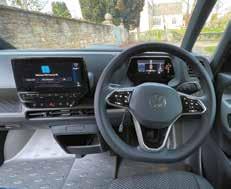
Again, the more time you’re in the Buzz, the easier this will get.
We only travelled 75 miles in the Buzz Cargo, mostly on B roads, some A roads and a stretch of the M40. Our Cargo range showed 231 miles when we climbed aboard. On A and B roads we used the B regeneration function and on the motorway drove at a steady 62mph, alone and unladen.
On our return some 2.5 hours later the range left was showing as 172 miles, so pretty impressive. Of course, you’ll need to factor in ambient temperatures, payload and urgency of your arrival, but we’d commit to an average range of 200 miles, 250 in warmer weather and 160 in colder weather.
Quite easily the best looking van you can buy. Brilliantly bolted together with on-trend tech and connectivity plus all of the safety features you could wish for. It’s also relaxing and easy to drive and gives a comfortable ride. Owning one definitely makes a statement.
It’s an EV so you have to get used to the fact that the driving range is much less than a Volkswagen Transporter diesel. The battery size and weight also eat into the rear load space, with only a 607kg or 592kg (Commerce Plus ) payload. By way of a comparison, the Vauxhall Vivaro Electric comes with a 1,000kg payload on it’s 75kWh battery offering.
Of all the electric vans we’ve driven, the ID.Buzz Cargo will divide opinion the most. Very good electric range compared to the competition but compromised by its carrying capacity, which is lower than the Citroen e-Berlingo or Fiat e-Doblo, for example. This may cause a dilemma for some but for us it misses the point: the ID.Buzz Cargo is the first electric van that puts style over substance, prioritising its classic history to create a look that very definitely stands out in a crowd. Volkswagen has, in our opinion, created a must-have van for those who want their business or product to stand out. Refreshingly different. CC&V
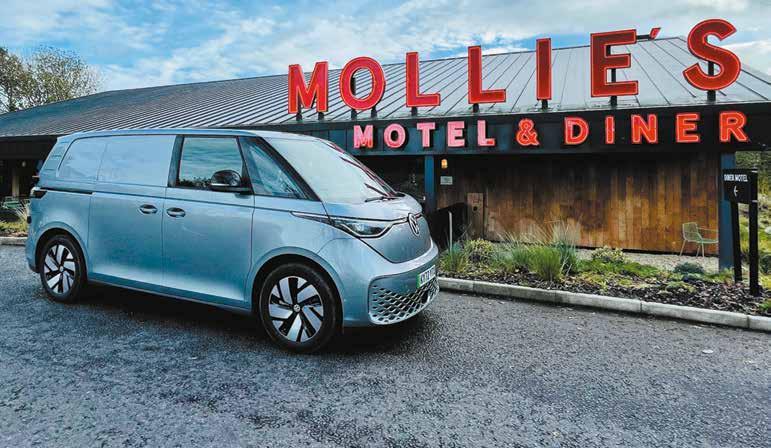
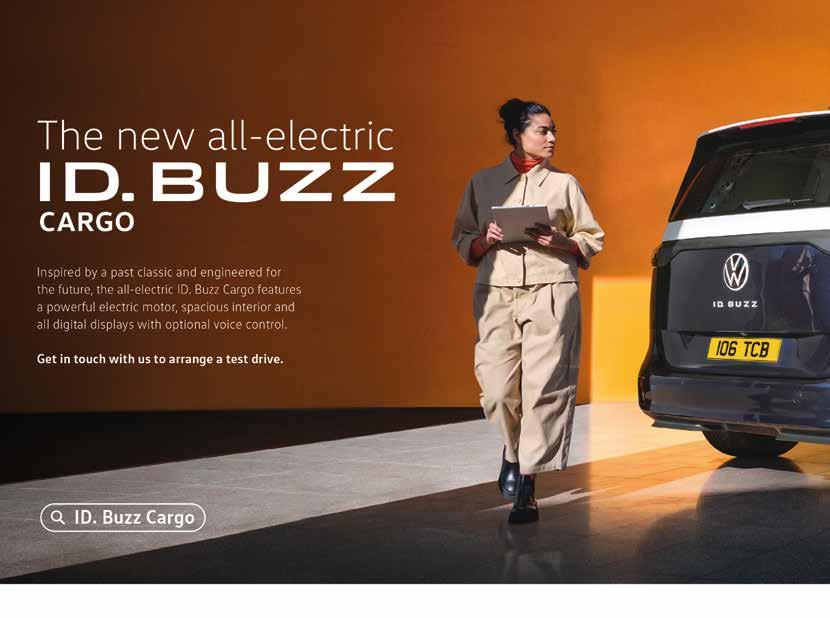



We were lucky enough to be invited to Ireland in March to take part in a Maxus electric driving challenge. It gave CC&V a chance to fully evaluate the electric options on this increasingly well-received range. First up was the Maxus T90 electric pick-up, which didn’t disappoint. First seen at the 2022 CV Show, it’s the first electric pick-up for the UK market.
It may be an electric pick-up, meaning there is a heavy battery fitted underneath the cab and load floor, but this doesn’t prevent it from offering a one-tonne payload and towing up to 1,500 kg. Looking at its length, width, height and load bed dimensions, they mirror a standard diesel pick-up, so it’s competitive.
Length: 5365mm
Width: 1900mm
Height: 1809mm
Wheelbase: 3155mm
Cargo bed area: 1510mm long x 1485mm wide x 530mm high
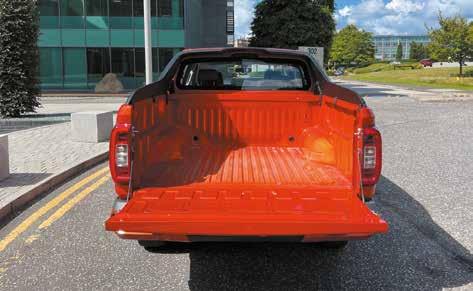
Maxus’ figures gives the T90 a 220-mile range, courtesy of its 88.5kWh battery. It produces 201bhp and powers a rear-wheel drive set up, which does means off-road capabilities could be affected.
Exterior
The front features a massive chrome grille with the Maxus logo at the top. The side LED daytime running light intakes bear a passing
resemblance to a Mitsubishi L200, while the rear load bed area is very similar to that on an Isuzu D-Max. The tailgate is heavy and closes with a nice clunk. There’s a large Maxus logo right across the rear, a high mounted stop light, with a step in the bumper to allow for easier access. The sides feature black steps and a chrome low door protector. Front and rear bumpers are body coloured.
Inside
Quality-wise, it’s pretty good, with the fixtures and fittings in keeping with those found on the Isuzu D-Max, Toyota Hilux and Mitsubishi L200.
If you’re expecting the more upmarket interiors found on a Ford Ranger Wildtrak or Volkswagen Amarok, however, you’ll be disappointed. It’s built to do a job, not for lifestyle.

There’s no gear lever. Instead, you’re presented with a cylindrical dial with a simple Reverse, Neutral or Drive option. Alongside this sit Power, Eco, Downhill and ASR buttons. The four-door pockets are sizeable with twin drinks holders located between the front seats, a centre armrest with storage underneath, although the glove box is small.
You also get a neat 10.5” infotainment touch
screen, an AM/FM radio and you can connect your Smartphone via Apple CarPlay, using one of the two front USBs that sit underneath. Separate climate controls are located underneath this with manual air-con fitted. You get a 12v socket up front, plus one in the rear as well as a 220v power outlet. The front seats are electrically adjustable, while the seat finishes are artificial leather.
Space in the rear is really good, so three adults should find it comfortable.
Plenty of safety in the form of ESP and EBA, driver and front passenger airbags and side airbags, with front to rear curtain airbags standard as well. You also get a reversing

camera, rear parking sensors and rain sensing wipers.
Extras
T90 can be spruced up with, among other items, the addition of a stainless steel sports bar, a roll lock cover, all terrain tyres, a mountain top/roller top, a tow bar with electrics, a front bumper winch pack or a hard top box with rear tailgate wash wipe.

Charging
T90 has a large battery giving it an excellent
range. The caveat, though, is that it will take longer to charge, approximately 12 hours from 0-100% on a 7kWh home charger. Better news is that if you utilise its DC capabilities, a 20-80% charge will only take 45 minutes. Supplied is a five-metre Type 2 charging cable with the external charging cap located on the rear left of the cab. As usual, our advice is to get a home charger, plug-in overnight when electricity is cheaper and get some chargers at your workplace too. It’s a sound investment.
Continued on page 50
It may be an electric pick up, meaning there is a heavy battery fitted underneath the cab and load floor, but this doesn’t prevent it from offering a one-tonne payload and towing up to 1,500 kg
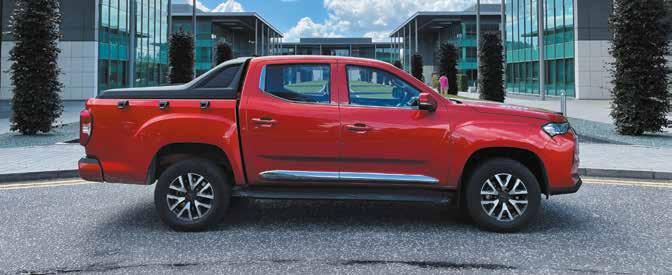
Dimensions
T90 dimensions mirror a standard diesel pick-up.
Length 5365mm
Width 1900mm
Height 1809mm
Wheelbase 3155mm
Cargo bed 1510mm (l) x 1485mm (w) x 530mm (h)
We drove from Dublin to Mayo, a course that took the T90 on a variety of urban roads, the motorway and then some country lanes. Apart from the electric whine when you first accelerate, the T90 is quiet, eerily so when compared to a standard diesel pick-up. Up front the ride is quite firm. In the rear we’d guess that, unlike on a diesel pick-up, where weight is all located at the front, the T90 with a heavy battery underneath the cabin floor won’t be as bouncy for rear passengers when unladen.
It’s very difficult to complain about anything that the T90 does on road. The cabin is quiet and comfortable, the dashboard and switches are easy to use and to understand. Having a left hand wiper stalk took some getting used to though. On the down side, our test T90 didn’t feature cruise control and we found the headlights weren’t very bright.
Charging on a fast charger added 60 miles in just 20 minutes and in a cold March with snow, the claimed range of 220 miles was most likely 150 miles with two adults on board. It will be interesting to see how it performs off-road.
All the dials and switches are easy to reach and to understand. The touchscreen is quite basic but the functions work well and Apple CarPlay connected seamlessly. AM and FM radio are standard, but if you want DAB you’ll need to connect to your favourite station via your Smartphone Apps. SatNav too.
Pros
First electric pick-up you can buy in the UK. Decent payload and load bed area. Electric range is impressive. Well equipped, quiet and surprisingly comfortable.
Cons
Weak headlights, range in cold weather drops considerably. We’ve yet to take it off-road and perhaps the low hanging motor-battery combo may affect ground clearance. At £49,950 + VAT it’s not cheap.

Conclusion
In the UK, Maxus has won the race to get an electric pick-up to market. Utilising parent company SAIC’s battery know-how, Maxus has gone from selling 100 vans in 2017 to over 12,000 in 2021, with its electric eDeliver 3 and
eDeliver 9 leading the charge. There are still no signs of an electric pick-up from Ford or Toyota, Isuzu or Volkswagen for that matter, giving Maxus a massive opportunity to make hay. Our only reservations are over off-road performance, as we haven’t tested it, and the price. Leasing will be the best way forward.
Top marks to Maxus for pulling off something of a coup with the first electric pick-up. Welcome to the future!
CC&V RATING:
